Moving home can be a stressful experience, especially with trying to balance work and
family life at the same time.
So, whether you've been relocated for work, going to study at university, or are simply
changing areas there are steps you can take to make moving in London less stressful.
Where should you start? What can you do yourself, and what help is available? We’ve put
together this helpful guide with advice to make sure your London house move goes as smoothly as possible.
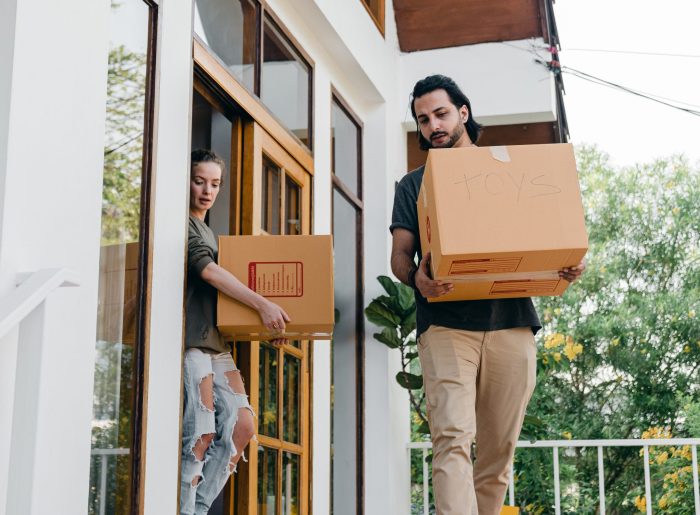
What You Should Do Before Moving
Declutter to Save Space
Moving will be much simpler if you start sorting through your possessions early. Plan what you'd like to take with you to your new home, what can go into storage and what you want to get rid of.
Think about what size your new place will be - are you downsizing? If so, try to be strict with your decluttering, you'll thank yourself later on. The more time you give yourself to declutter, the more relaxed the moving process will be.
It can be difficult to know where to begin when it comes to decluttering, especially if you have a lot of belongings. To help you with the decluttering process, .try to give yourself 4 categories which you can break it up into.
- Keep - This pile is for the belongings that you definitely want to keep. This could be your clothes, things you use daily, as well as valuable items.
- Store - In this group, place seasonal items as well as belongings that you don't use regularly but are unsure at the moment whether you should keep or bin.
- Bin - As time goes on, it's easy to accumulate a lot of stuff that you end up hoarding. This is a perfect opportunity to bin these items if they are not worth donating or selling.
- Donate or Sell - A great way to declutter your belongings is to make a pile that you can take to a local charity shop. Or, if you think you could make a profit out of them, you could sell them online.
Decide How You’ll Move Your Belongings
There are a few options when it comes to moving your belongings in London. You can either hire your own vehicle and do it yourself, or you can hire a removal company. Both options have their own perks, and a good way to decide which one to choose is to consider how much stuff you actually need to move.
Alternatively, a more flexible option you can place some items into box storage to reduce the amount of things you have to move and then order them to be returned to your new home once you’re settled in.
Make a Moving Checklist
A good way to stay on track with your relocation is to create a checklist that is a comprehensive record of everything that goes into your move. Writing down what outstanding tasks you need to complete before moving house will help alleviate some stress. We have created this helpful moving home checklist to help with your home move in London.
Start Packing Your Belongings
Once you've decluttered and created your checklist, it's time to start packing. It's much better to pack things away gradually, instead of leaving it until the last minute.
An efficient way of packing is to start at the top of the house and work your way downwards. This is so you don't find yourself in a sea of boxes.
If you start with the least used items or pieces of furniture such as seasonal clothes, sports equipment and books. As well as the expensive silverware, china sets and all plates you only use occasionally. These will then be out of your way without you worrying that you'll need them again.
Leave your everyday clothes, toiletries, documents, and medicines until last, as well as your bed and mattress.
As you go, remember to label each box with the name of the room they go in as well as what is in the box, so you don't get confused when unpacking. You can use your checklist to assign items to boxes and tick them off when they are packed away.
Knowing Your Storage Options
If you found that you had a lot of things that you weren't sure whether to keep or bin, or, if your new home isn't ready straight away and you have to rent somewhere in between moves, short-term storage might be the best option for you.
Access Box Storage can provide you with convenient and affordable storage options. All you need to do is enter your London postcode into our search bar to make a booking and select how many boxes and larger items you’d like to store and for how long. We’ll provide you with free boxes, collect your boxes and deliver them to your new address whenever you’re ready!
Many of us allow clutter to build up in our homes, but how far does this issue go? We wanted to find out more about the UK’s clutter habits, including what is the most hoarded item, why we hoard, and how this affects our lives.
The most hoarded items
Our survey reveals that clothes are the most commonly hoarded item in the UK, with 61.1% of people admitting to cluttered closets. There are many reasons people may keep clothes; for nostalgic reasons, in hopes they’ll fit again one day, saving for a special occasion, or simply feeling guilty getting rid of them after spending hard-earned money.
Other commonly hoarded items include plastic bags and bags for life, cards and gift bags, and containers such as shoe boxes.
Reasons for keeping clutter
The majority of people don’t part with common clutter items in case they can be reused. Whilst it’s great that people are being environmentally conscious, the excuse of ‘I can reuse it’ tends to go unfulfilled - wardrobes remain cluttered with clothes from 2010, and the numerous shoe boxes continue to pile up…
Sentimentality is another big reason people tend to keep items - this is much more understandable, however, there is a fine line between being sentimental and hoarding. Of course, keeping a card from a loved one who has passed is fine, but keeping a receipt from a holiday when you were ten may be crossing the line. Chances are you never look at the item - getting rid of it will not result in the memory fading.
Clutter in the home
Our data revealed that over 90% of the UK public have clutter in their home - just 7.4% claim to have none at all. These commonly hoarded items tend to be kept in cupboards and drawers, followed by the attic or loft. With UK homes getting smaller, the need to reduce this clutter is more important than ever.
There are a range of issues that can stem from cluttered homes. Too much clutter can affect our mental health - 47.2% of respondents admitted that clutter in their home makes them feel stressed, and 22.2% said it annoys/upsets them.
Katrina Hassan, founder of Spark Joy London, said: “I fully believe that decluttering the home has the power to transform one's life. I'm certainly proof of that. I used the KonMari Method (made famous by Japanese professional organiser Marie Kondo) to declutter and organise my home when I was preparing for a home birth with my son. What I didn't expect from going through all of the categories, was the powerful impact it would have on my decision making for all other aspects of my life. My head was so clear that I was able to identify that my career as a primary school teacher no longer sparked joy.”
Another issue is conflict between household members - our data revealed that over 80% of respondents said clutter had caused issues with their family/housemates. Nobody wants to live in a cluttered, messy home, so it's understandable that this can affect relationships.
Lisa Pantling, Membership Director of the Association of Professional Declutterers and Organisers (APDO), said: “I will usually refer to clutter as 'visual noise' and if everywhere you look there are little piles of clutter and mess some people find it impossible to relax. And all the worse if it's not even their stuff, or they feel that they have repeatedly asked for it to be sorted and nothing has happened.”
Minimising clutter
Our survey revealed that the majority of the UK public tend to declutter their homes every few months, however, just over 8% of people say they rarely or never declutter. It’s important to declutter your home regularly to prevent it from building up and turning into a bigger issue.
Lisa commented: “A good sort out once every 6 months will be just what we need to keep everything 'current' and uncluttered. But for others, it is more of a process than an event, and it will be a case of working through the clutter at a slow, steady and manageable pace.”
Over 70% of respondents would like more space in their home according to our survey. Decluttering can be a daunting task, but if it is kept on top of it will be much easier, can create more space in the home, and overall will benefit your life.
Here are some tips on decluttering your home and keeping on top of it:
Do a little bit at a time
Trying to declutter your whole house at once can be overwhelming. Penny Moyses, Founder and Event Director of the Clean & Tidy Home Show, said: “Use your time effectively. Even going through your letters or kitchen worktop while the kettle is boiling will help you to save precious time.”
In line with Penny’s comments, you might consider doing a room at a time or allocating five minutes a day to get into a routine. Penny adds: “If what you want or need to achieve seems unachievable, break it down into smaller goals e.g. start with a small drawer.”
Katria suggests organising by category: “ Instead of decluttering one room, one space or one drawer at a time, we tidy one category at a time. We start with clothing, before moving on to books, papers, komono (miscellaneous items) and complete our tidying process with sentimental items.”
Make a list
Before starting, create a list stating what you want to achieve, e.g., declutter the wardrobe, organise the mail. You can make a big overall list, or create lists for each day or amount of time you’re spending decluttering.
Use a storage facility
It can be hard to part with certain items, especially if they’re valuable or sentimental. Consider using secure box storage so you still have these items, but they’re not cluttering your home.
Have categorised boxes or bags at the ready
Sort your items into 'donate', 'keep', 'throw’ or any other categories you choose. Having boxes/bags ready can help motivate you to make these tough decisions.
Lisa added: Have a donation box or bag ‘on the go’ so whenever you notice something isn’t serving you it can go in the bag, and when the bag is full it can be taken straight to the charity shop!”
Ask for help
If you’re struggling with decluttering, you could ask a family member or friend for help. You could also hire a professional declutterer - the APDO website allows you to find professional organisers and declutters in your area.
Does it spark joy?
Marie Kondo is the queen of decluttering and organisation, so follow her sixth rule for tidying. Pick up the item and ask yourself ‘does this spark joy?’ If the answer is yes, keep the item - if it’s no, get rid of it.
Katrina said: “Write down trigger areas in your home as it is now. What is joyful in your home? What are the necessary things you need to do? What are the waste elements? Is there any opportunity to let go of any of the wasteful elements in your home? Once you have assessed your current reality, the next step is to create your vision of your ideal lifestyle and ideal living environment. Write down your ideal living environment that allows you to be joyful, productive and present, allowing time for self-care.”
One in one out
If you have clutter due to buying a lot of items, try to use the ‘one in, one out' rule - every time you buy a new item, you need to get rid of something you already have and no longer need.
Have organisational items
It's important to have items that help with storage and organisation (baskets, shelves, etc.) to stay on top of your clutter. Lisa said: "Professional Organisers will generally advise decluttering before trying to organise anything, which does usually work for most of us. However, if you are finding it hard to let go, you might benefit from organising the items into categories first so you can really see how much you have to help you decide what you really love/need enough to keep it."
Our data also revealed that almost 85% of people would like their homes to be more minimalistic to some extent. Decluttering can help you achieve a more minimalistic lifestyle.
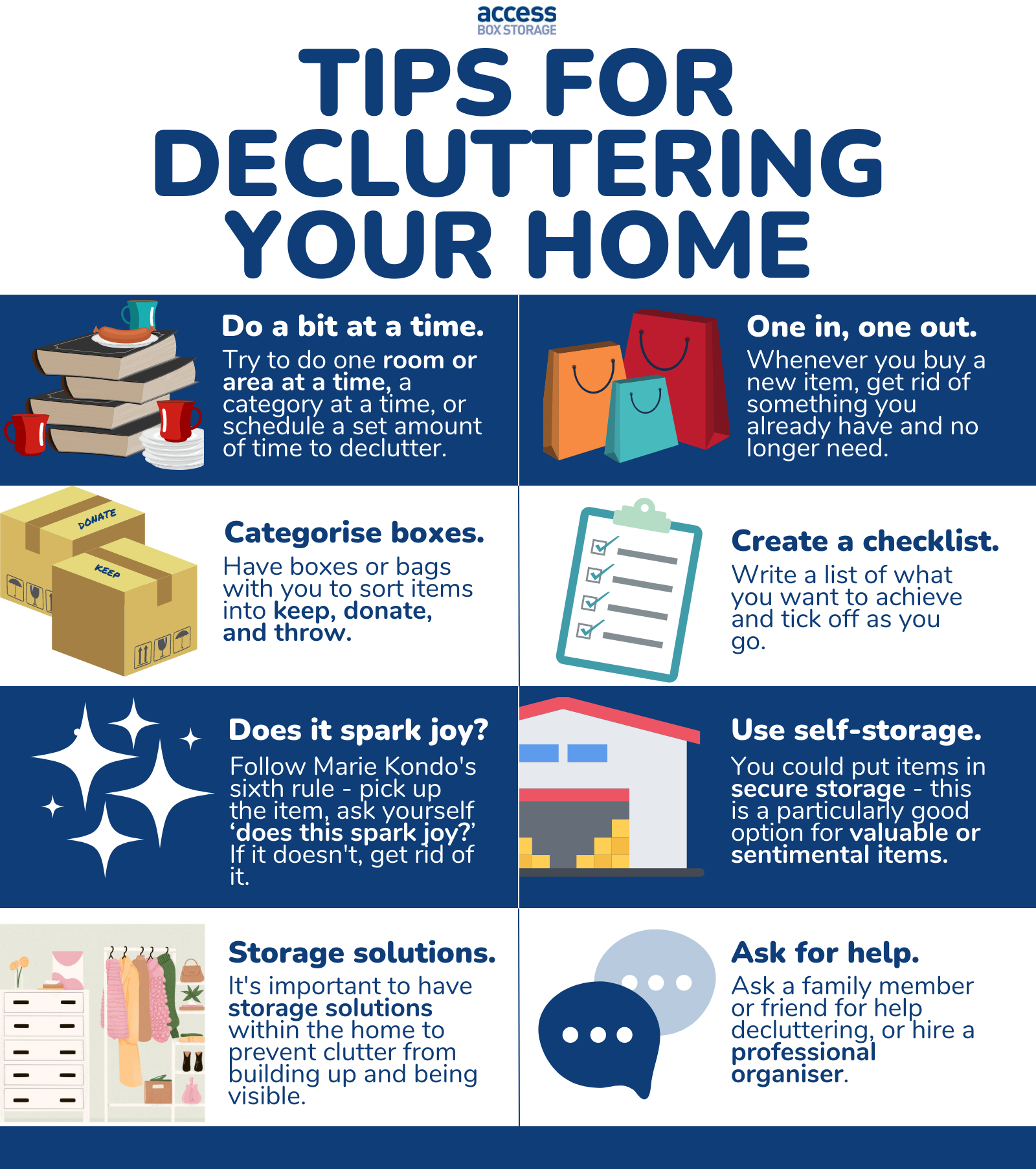
Lisa commented: “Having an organised home and simple systems in place can have a positive effect on every part of our lives. A clear kitchen makes it easier to plan and cook healthy meals, a clutter-free bedroom makes for a good night’s sleep and an easier morning routine.”
When clutter becomes a problem
Despite many respondents admitting they hoard items such as clothes, containers, and packaging, just 25% consider themselves to be hoarders.
There is a big difference between clutter and hoarding…
Clutter is a less severe form of hoarding and can be used to refer to unorganised mounds of objects that can build over time in drawers, on tables, and around the home. Whilst clutter is a common sign of hoarding, it doesn’t mean that somebody has a hoarding disorder or is showing hoarding behaviour. It is fairly common to have clutter in the home. Certain periods of life become busy and decluttering may not be a huge priority during these times.
Hoarding on the other hand is much more complicated.
The NHS states hoarding is when “some acquires an excessive number of items and stores them in a chaotic manner, usually resulting in unmanageable amounts of clutter.”Megan Karnes, chair of UK Charity HoardingUK, said: “The way hoarding is usually defined is in regard to the impact on the space and the person’s safety and living habitability. We judge this using the clutter image rating - if a person is at a level five we would consider that person having the house impacted significantly enough for that to be considered hoarding.”
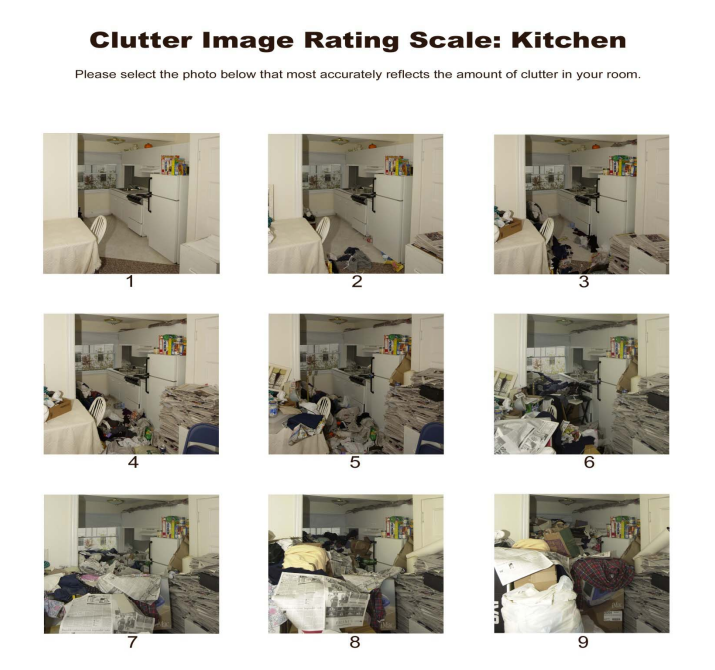
Megan continued: “The clinical criteria is the pattern of behaviour that brings the person to this level, so hoarding is actually a symptom.”
Hoarding Disorder
Hoarding is now a clinically recognised mental health disorder - it was recognised in the Diagnostical Statistical Manual in America in 2018, and in the international classification of diseases in 2018.
Megan comments: “It’s important to remember that a person who is hoarding is in psychological distress - this is manifested visually for this person. Many people have experienced trauma, but you don't physically see this for the average person as you do for somebody who hoards. We need to begin to associate the ‘stuff’ with a person’s stress, anxiety, and potential trauma.”
Causes of hoarding
Hoarding behaviour can be a result of many factors - it is an anxiety disorder that falls under the obsessive-compulsive spectrum, so people suffering from either anxiety or OCD may show hoarding behaviour. In recent years, mania in bipolar disorder has been found to trigger excessive acquisition, psychosis can also trigger this and specifically affect the self-neglect spectrum of hoarding. Attention deficit hyperactivity disorder (ADHD) has also been linked to hoarding and is perhaps the most common trigger - this disorder can make it difficult for people to make decisions.
Megan commented: “Clinicians might disagree with me, but in my twenty years of experience I will always say that every person I have worked with has experienced a lived trauma that changed their life such as losing a partner, or a job, or an opportunity - the trauma they’ve experienced may not necessarily be clinically recognised but it has impacted them and played a part in their hoarding.”
Lisa added: “Common contributors to the mental health condition of hoarding disorder are often related to childhood trauma, PTSD, complex grief disorder and multiple bereavements, along with other mental health conditions such as depression and anxiety.”
Problems caused by hoarding behaviour
Hoarding behaviour can lead to a range of further issues, including physical and mental health, relationship problems, financial problems and more.
Megan said: “Hoarding creates problems in all areas of a person’s life. Mould, dust, and damp are present in any significant level of hoarding which can result in chronic lung issues. We’ve had people with scurvy, Vitamin D efficiency and mobility issues due to hoarding.”
Relationships can also become damaged due to hoarding behaviour - a sufferer may avoid inviting family and friends over resulting in a breakdown of a relationship, partners who live in the home may become distressed due to the state of the home.
Megan added: “Many people within our support models have broken families and people not speaking to each other. We’ve had stories of partners becoming distressed but understanding it’s an issue and remaining as supportive as they can be, and stories of people being called ‘stupid’ by partners.”
Lisa commented: “When a home becomes dangerously full it can lead to an increased risk from fire, trips and falls, poor sleep and diet and often isolation and this can lead to a severe decline in mental health and general wellbeing. That being said, it is a strong-willed and resilient person who can continue to function in a hoarded home, which may have fallen into disrepair and even lack heating or hot water.”
Other issues that can be caused include financial, psychological, practical, and even legal.
Signs of hoarding behaviour
There are certain red flags to look out for if you or somebody you know are unsure whether they have a problem…
- Buying many of the same items
- Not inviting people over due to clutter/mess
- Issues amongst friends and family over clutter
- Feeling out of control about the clutter
- Clutter causing health issues or danger in the home
- Money issues as a result of hoarding
Comparing the amount of clutter to the clutter image rating can also reveal whether somebody is exhibiting hoarding behaviours - if the amount of clutter is on a level one to four, then it is likely simply a case of the home being messy and chaotic, but it is not as dangerous as it could be.
Megan commented: “if we see the clutter index rating go from a three to a five, this is when we should begin asking them what’s wrong and if they’re okay.”
Moving forward
If you feel you’re suffering from hoarding behaviour and potentially hoarding disorder, it’s important to seek support. Whilst this can be difficult, there is help out there, such as HoardingUK which has a free helpline, in-house support for those based in London, and run numerous virtual and in-person sessions across the country.
Megan said: “There are services out there that can help cut down clutter and clean up spaces which is great, but they don’t necessarily help people with their hoarding disorder. We work with people in the long term with a model that works.”
“Be kind to yourself and understand that hoarding disorder is real - it’s not a character flaw or personality trait,” Megan advised.
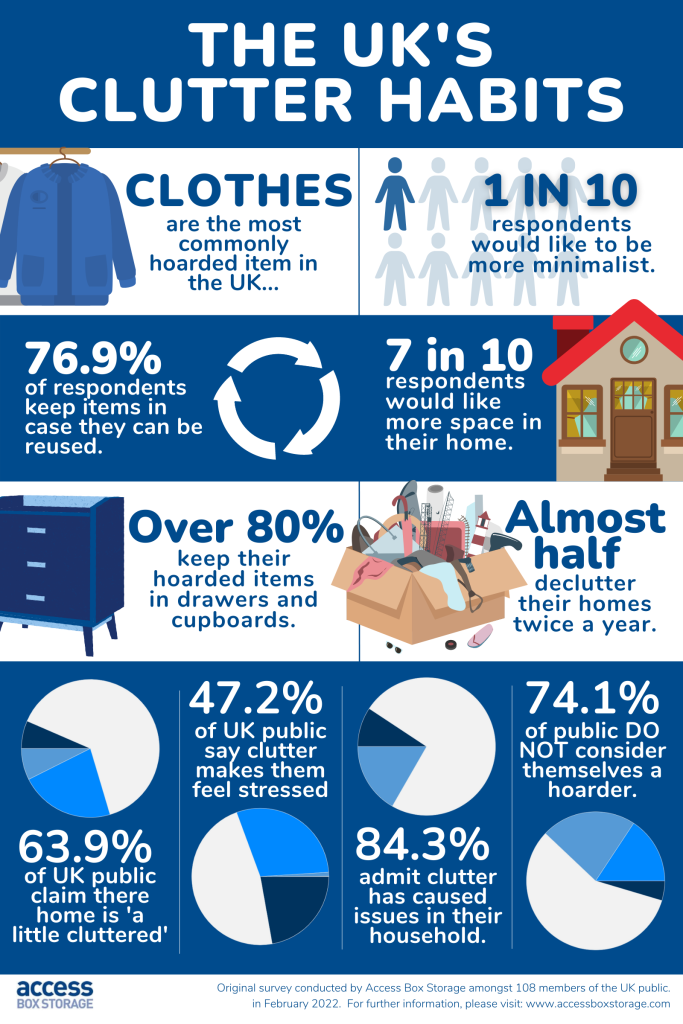
Do you feel like you have more stuff than space? There may not be any more room in your loft or garage. Or, perhaps, you’re looking to sell your house and need to store your furniture until you move into your new home.
You may start looking for storage solutions but come across self-storage and box storage and wonder what the difference is. To help you decide which option is best for you, we have put together this handy guide.
Self-Storage
A self-storage unit provides flexible, secure storage for your belongings. You will be able to choose what size unit you need and take your belongings there yourself and store them for however long you like.
You will be able to access the unit whenever you require and remove your belongings at any time, making it a good option if you would like easy access.
Advantages of Self-Storage
Some advantages of self-storage include accessibility and safety and security.
Accessibility
A self-storage unit is more readily accessible as the facilities are open 7 days a week for you to come and go as you please.
Safety & Security
A self-storage unit is highly secure and protected by 24-hour recorded CCTV and comprehensive alarm systems. You will also be the only one to have access to the unit.
Disadvantages of Self-Storage
The disadvantage of self-storage is that you will need to get your belongings to and from the unit, rather than having access to delivery drivers.
What is Box Storage?
If you don’t need immediate access to your belongings during storage, box storage could be the solution for you.
Box storage doesn’t require you to rent a storage unit, a storage provider will come and pick up your belongings and store them in their storage facility.
They will provide you with the boxes, so you can pack at your leisure and then collect your boxes at a time that is convenient to you. When you need your boxes back the box storage company will return them to.
Advantages of Box Storage
Some advantages of box storage include convenience and price.
Convenience
By using a box storage provider, a major advantage is convenience. You can get your boxes collected, stored, and returned without having to leave your front door. You don’t need a car or need to find a removal company to help you prepare and transport your stuff to storage. This means there are no worries about coordinating multiple companies when it comes to moving day.
Price
Unlike self-storage where you pay for a certain amount of space which can often go to waste, box storage allows you to pay only for what you store. This is cost-effective if you only need to store smaller items or a couple of boxes.
Safety & Security
Box storage facilities are highly secure and protected by 24-hour recorded CCTV and comprehensive alarm systems. No one has access to these facilities but the staff that works there.
What to Consider When Choosing Self-Storage or Box Storage
Choosing between self-storage and box storage is mostly dependent on what you need from storage and what you’re storing.
Box storage works best for people who want to store small items and boxes and who don’t need to access them regularly. Self-storage works best for people storing many large items and who require the ability to access their storage unit whenever they please.
We’ve put together this table of helpful considerations to make when choosing between box storage and self-storage:
| Considerations | Self Storage | Box Storage |
| How often do you need to access your items? | Be able to access your items regularly. | Don’t need access to your items regularly. |
| What do you need to store? | Better for large items or if you’re storing a lot of stuff. | Better for small items and boxes. |
| Flexibility | Can’t easily change unit size. You will have to move your stuff. | Can easily increase or decrease the amount of boxes you store. |
| Cost | Pay for a space to store your things. This may mean you don’t use all the space efficiently. | Pay only for what you store. |
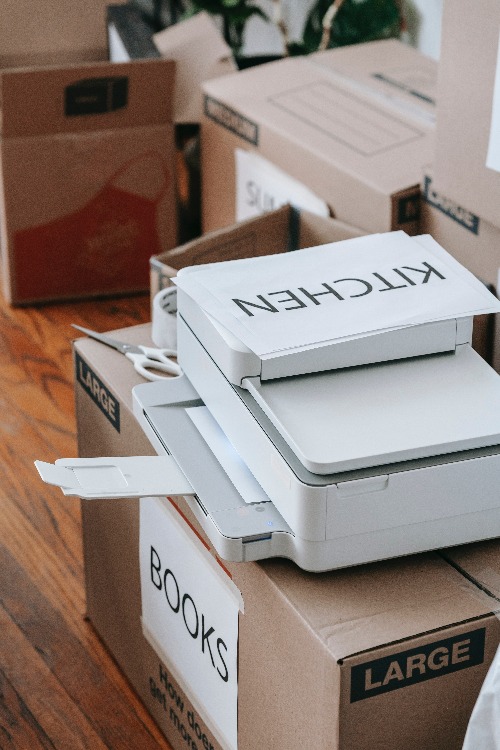
Ready to Start Using Box Storage?
If you decide to choose box storage, Access Box Storage can help you out.
Simply enter your London postcode into our search bar to make a booking and select how many boxes and larger items you’d like to store and how long for. We’ll provide you with free boxes. Then, you can take your time packing and storing, and we’ll come to collect your boxes whenever you’re ready! It couldn’t be easier.
Check out our FAQs if you have any questions or get in touch with us today.
While so much of marketing today is digital, businesses still use physical marketing collateral such as posters, leaflets and brochures at in-person events. As these build up over time, there is a risk of the collateral becoming disorganised, damaged or lost when not stored correctly for long periods. If you regularly use your marketing materials such as leaflets for events that happen a handful of times per year, it can quickly become costly to throw away and reorder what you need between occasions.
Storing your marketing collateral in the office leads to clutter and takes up valuable space. By using a secure box storage service, you can store and retrieve your marketing collateral when not in use.
To make sure you select the right storage service for your marketing storage needs, we’ve put together some key points to consider to help with your decision.

What is the Best Way to Store Marketing Collateral?
Storing collateral and event materials off-site provides space in your office for more important things. But, it’s important to choose the right storage company that is flexible, convenient and can store your collateral safely.
Things like being able to choose the day and time you want your items collected or returned mean you have your marketing collateral when you need it and it’s out of sight when you don’t.
What you pack your marketing collateral and leaflets inside is also important for keeping them safe. Make sure the storage company you choose uses high-quality storage boxes. Some even provide them for free – we do! Once you’ve packed your paperwork into boxes you are going to need to seal and label them. Use quality packing tape to seal all the boxes seams to prevent dust from building up inside them over time. Label your boxes to keep them organised. Many businesses label by marketing campaign or event so they can return only specific boxes when they need them. Make sure the box storage company you select provides these for you.
The Value of Storage by The Box
At first, it may not seem like you need to store your marketing collateral, but as more collateral is created for more events it can quickly become overwhelming to organise and remember where you have stored them. Using box storage means your stored marketing materials are organised in boxes, out of the way and can easily be returned to you whenever you need them. Simple and convenient, there’s no need to even leave your office.
Box storage is also often more affordable than other storage options. This is because you only pay for the boxes that you store. It’s also easy to add or reduce the number of boxes you store over time.
Securely Storing Marketing Materials
While storing marketing materials when they’re not needed makes sense so you don’t have to throw away and reorder new stock for each event. You will want reassurance that your collateral won’t get damaged whilst in storage.
When choosing a box storage company, you should consider what kind of facility your items are being stored in. Storage facilities like the ones we use at Access Box Storage are secure, clean and organised to give you the reassurance that your stored away marketing materials are safely stored ready to be used again.
Using Access Box Storage to Store Your Marketing Materials
If you’re looking for secure, clean, convenient and affordable box storage, you can store with us by simply entering your London postcode into our search bar to begin. You can make a booking and select how many boxes you’d like for your paperwork and how long you’d like us to store it for. We’ll provide you with free boxes. Then, you can take your time packing and storing, and we’ll come to collect your boxes whenever you’re ready! It couldn’t be easier.
Check out our FAQs if you have any questions or get in touch with us today.
Once all the excitement of Halloween is over, the thought of taking down all your decorations and storing costumes, wigs, and accessories needed for large events could be tiresome. You need a plan.
Using box storage is a great way to keep everything organised and ensures that your Halloween decor stays in good condition until next year.
To help you prepare your Halloween storage, we’ve put together some tips and tricks for you to follow.

1. Get Sorting
The thought of sorting your Halloween decor may seem daunting, particularly if you have a large event space or shop. But the best way to begin sorting is actually to start whilst your decorations are still in use. Make a note of everything you’d like to store and what requires to be thrown away or donated. That way, when it’s time to take them down, you already have a clear idea of the items you require to prioritise.
Once you have done this, you can start sorting your items into groups, whether that be according to a theme, location, or type. Have a think about how you want to find your items when it’s time to decorate this time next year.
When your items are grouped together, you’ll want to decide how many boxes and how much packing material you’ll need. Access Box Storage provides free cardboard boxes for you to use for your Halloween storage, and we also provide packing materials at the checkout.
Then, it’s time to start packing!
2. Store Your Halloween Costumes
There can be so many components to an adult Halloween costume, including clothing,
headgear, masks, capes, and canes, that it makes sense to store it properly to be recycled
for another year.
Before storing, we recommend cleaning everything first. Whether that’s machine washing or
hand washing your costumes and wiping down your headgear and masks. Let it all dry out to
prevent any moisture from getting into the cardboard boxes.
You can choose to put your fabric costumes in garment bags or wrap in tissue paper for
extra protection, and then store them in our cardboard boxes. For accessories like headgear
and masks, you can wrap them in bubble wrap first and then store them in a separate box
from your costumes.
3. Store Your Halloween Wigs
If your Halloween storage includes a wig, the first thing to do is wash it straight after you have worn it. Typically, it’s recommended to wash a wig every 10 times you wear it. But if you’re planning to wear it once and store it for the rest of the year, it’s better to clean it, so it’ll be as fresh as possible for next Halloween.
When washing your wig, make sure you only use specific products made for synthetic or human hair wigs, which can be found at wig stores or bought online.
Once it’s washed, place the wig on a towel on a flat surface to dry out. This is better than blow-drying as this can damage the fibres and stretch the cap.
Once it’s dry, detangle the wig using a comb and then fold the wig from ear to ear and place it in a hairnet before storing it in your cardboard box.
4. Store Your Halloween Decorations
Some Halloween decorations are fragile or made of glass. Some are electronic and have lights or speakers, and others are strung on cords or strings. All of these need to be taken into account when packing.
If you have the original boxes, we recommend putting the decorations in there first and then packing them in our cardboard boxes. However, if you don’t, be sure to use bubble wrap or tissue paper to protect these items before packing them.
5. Label Everything
Once everything is stored in your cardboard boxes, it’s a good idea to label everything in your Halloween storage. This is so when Halloween rolls around next year, you’ll be able to let us know which boxes you’d like to be delivered back to you. As well as making your life easier knowing what is in which box.
Use Access Box for your Halloween Storage
So, if you’re ready to start storing your Halloween storage with Access Box, the process is very simple and most importantly affordable at £7.50 per box.
Firstly, type in your postcode to check that you are located within our London service area, and then select how many boxes you need to store your Halloween decor and how long for. As well as these free boxes, you can choose if you require any packing materials sent to you.
Then, select a date and time that is convenient for you for your boxes to be delivered, so you can get on with packing. We will then come and collect your storage boxes and take them to our safe and secure storage facility.
Taking down your Halloween decor and saying goodbye to the spooky season for another year may be sad, but at least you can rest easy knowing that Access Box Storage has everything ready for you next year. You can simply log into your online account and book a return date - it’s that simple!
As the seasons change, you'll probably find yourself with a tonne of clothes that you have no intention of wearing for the months ahead. Unless you have a spacious walk-in wardrobe, finding an out of season clothes storage space is essential to organising your wardrobe space.
So, get started with our clothing storage ideas and save yourself wasted time searching through your clothes or squeezing them back into your wardrobe after doing laundry.
4 Helpful Tips for Storing Your Out of Season Clothes

1. Clear Out Your Wardrobe Before Storing
When the weather changes and the warmer or colder months creep up on us, it's a great time to review your wardrobe and decide what you no longer want to wear. We are all guilty of having a few items of clothing that we forget are lurking at the back of the wardrobe.
If you have not worn a piece of clothing for more than a year, you might want to consider throwing them away or taking them to a charity shop.
2. Wash Your Clothes Before Packing
Now that you've cleared out your wardrobe, it will make packing and storing your clothing a much simpler process.
We recommend washing all your clothes that you plan to store before packing them away, so you avoid mould growth and odours spreading. Try to remove any stains and consider taking a trip to the dry cleaners for any delicate items.
3. Do Not Store Your Clothing in Plastic Bags for Too Long
The reason for this tip is that most clothing fabrics need to breathe to prevent moisture from building up which can cause odours and mould to grow.
Placing them in airtight plastic bags, vacuum seal bags and plastic dry-cleaning covers will prevent the fabric from breathing and can potentially damage your clothes.
Storing your clothes in a cardboard box will mean that you will be able to keep your clothes aerated so they can last longer when placed into storage.
4. Fold Your Out of Season Clothes
Even though your clothes will be sitting in a storage facility for a period of time, we wouldn’t recommend stuffing them into a box. They could possibly get crumpled or damaged, which could potentially ruin them when the season is right for them again.
When packing your out of season clothes, we recommend folding items such as t-shirts, jumpers, trousers, and jackets where they can be easily packed into a storage box without damage. Our storage boxes have a maximum weight of 25kg, which gives you room to store plenty of your out of season clothes if you fold them neatly.
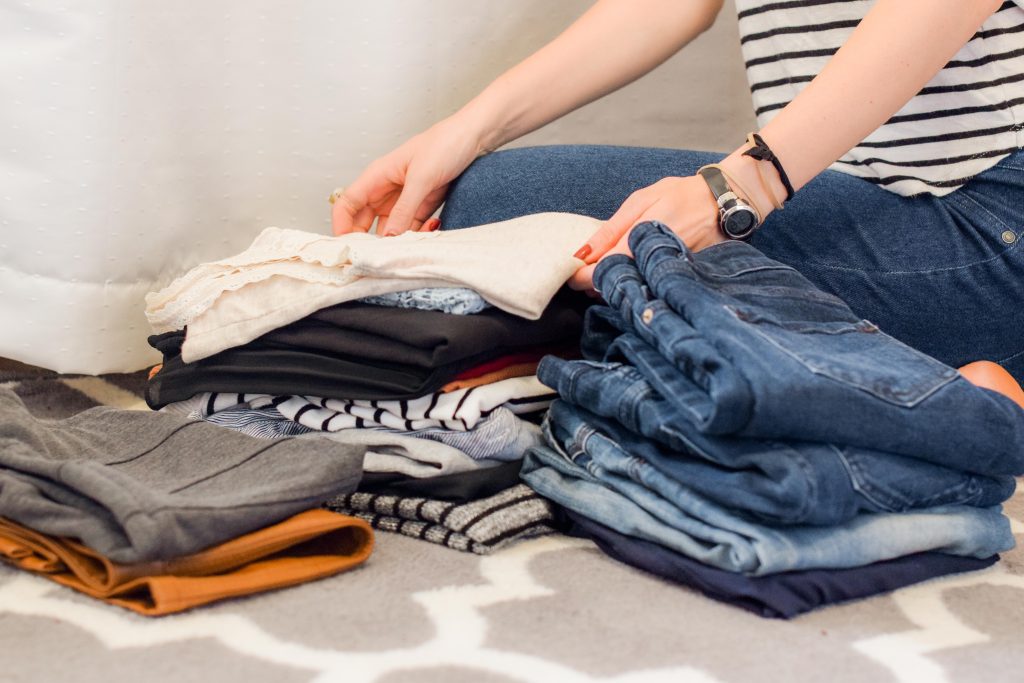
Try Using a Box Storage Facility For Storing Out of Season Clothes
Due to having limited space at home to store your out of season clothes, you might consider putting your belongings in a shed or a garage. However, this could pose a potential theft risk as well as conditions that could cause damage to your clothes.
Using a box storage facility could be the solution you need. At Access Box Storage, our purpose-built London storage facility is safe and secure as it is monitored by 24/7 CCTV and secured by a fenced perimeter and fire detection systems.
We store your items by the box, which works out much cheaper than it is to store in a self-storage unit.
We operate box storage with a pickup and delivery service, which means we can drop off our Access Box Storage boxes at your London postcode for free. We then return to collect them at a later date after you have packed. Then, when you are ready, we will deliver your boxes back to your location.
So, if you choose to store your out of season clothes with a box storage provider such as Access Box Storage, we have some top tips you should consider when packing your items and how to book this type of storage with us.
How to Book Out of Season Clothes Storage with Access Box Storage
Firstly, type in your London postcode and then select how many boxes you need to store your out of season clothes and for how long you want to store them. We provide free boxes and sell packing materials which we deliver with your boxes. No need to go out and purchase these separately.
Next, select a delivery date and time that is convenient for you. We will deliver your boxes and packaging and let you get on with packing. When you’re finished, we will then come and collect your packed boxes and take them to our secure storage facility.
When the seasons change back around, simply log into your online account and book a return date for your storage boxes to be returned to you.
Using box storage is the perfect way to store belongings, whether you’re a student storing belongings for the summer or moving home.
It's a convenient solution and can be more cost-effective than using a traditional storage unit.
However, the thought of organising your stuff to be stored can be a bit overwhelming, particularly if you have a lot to put away. So, we’ve put together these helpful tips on how you can create the perfect system to organise your belongings before putting them into storage.
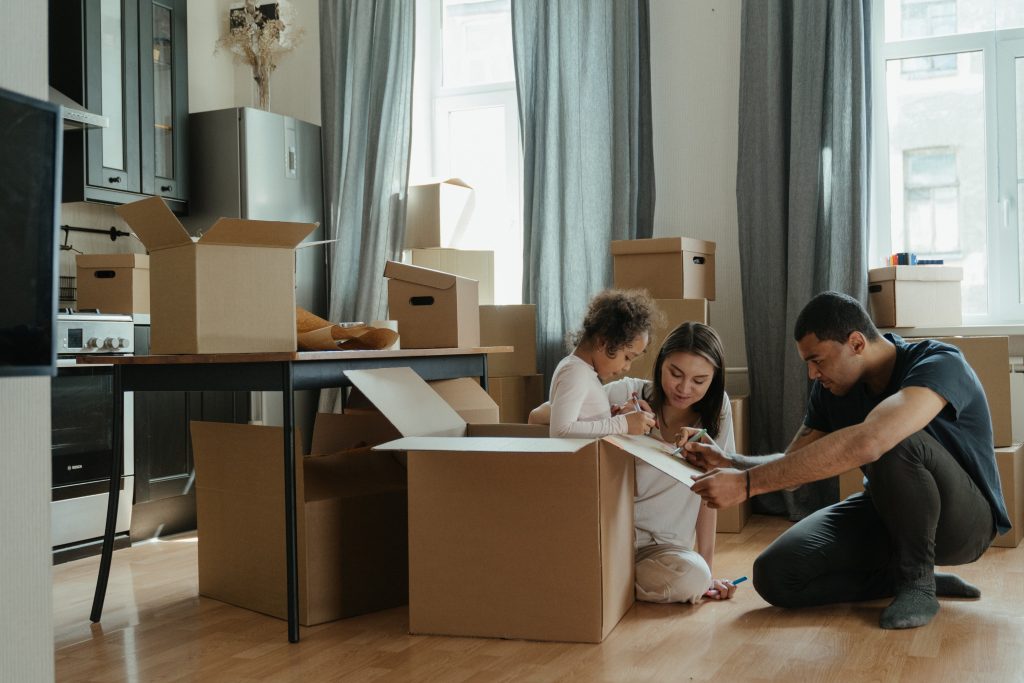
Step 1. Declutter
Depending on what you’re storing, this first step can be a little tricky, but if you do it right, it’s one of the most effective ways to figure out what to store.
Decluttering allows you to go through your things and understand what you have and what you want to throw away. This step can reduce a lot of the stress when packing later, as you’ll have already sorted out the belongings that you want to keep and place into box storage.
Step 2. Clean Your Belongings
While you’re organising and decluttering, you may want to clean your items before storing them. You’ll be surprised at how cleaning your stuff before storing helps prevent dust build-up. We recommend wiping down hard items, washing any clothes you’re storing and vacuuming soft items, like cushions or pillows, before packing them into boxes.
Step 3. Organise Your Stuff
After you've decluttered and cleaned your stuff, the next step is the centre of the organisation process.
When you're placing a lot of items in storage, it can become difficult to remember everything you have. While some things are easy to remember, smaller items can often be forgotten about after months of storage.
To help you keep track of everything you’re storing, it’s a good idea to group items together. This could be by year, material, location, or size. Everyone is different, someone storing lots of clothes will have different needs to someone with a huge amount of DVDs.
We then recommend creating a list of all the items you want to store and, as you begin packing, tick each item off the list.

Step 4. Pack Your Boxes
Once you've organised your items, the next step is to pack your storage boxes. When storing with Access Box Storage, we provide as many storage boxes as you need for free, to make your move as smooth as possible.
We have some top tips for packing your items safely and securely:
- First, line your storage boxes with bubble wrap to prevent any damage to your items. You can buy packaging materials during our checkout process, so no need to worry about purchasing these separately.
- For any delicate or fragile items, wrap them in more bubble wrap for extra protection.
- We recommend packing your box by placing the softest items at the bottom and top of the box, with your most precious items in the middle.
- Pad out any extra space in your boxes with scrunched up pieces of tissue paper.
- Use parcel tape to securely seal your storage boxes along all seams.
Step 5. Label Your Boxes
When you’re packing your items for storage, it’s a good idea to label your boxes as you’re packing them. This is a great way to keep track of which boxes you’ve put your stuff in.
On the top of our free boxes there is space to write your name, order number, box number, and box contents. It’s also a good idea to write this down on a separate piece of paper to help you remember which boxes you need returning. We use this information to return the correct boxes to you when you need access to your stuff.
Ready to Store?
So, if you’re looking for cheap box storage in London, Access Box Storage can help you out.
Simply enter your London postcode into our search bar to make a booking and select how many boxes and larger items you’d like to store and how long for. We’ll provide you with free boxes. Then, you can take your time packing and storing, and we’ll come to collect your boxes whenever you’re ready! It couldn’t be easier.
Check out our FAQs if you have any questions or get in touch with us today.
A few things are as exciting as holding in your hand your first flat’s keys. Are you new to the renting world and approaching renting a flat for the first time?

If you are starting to look for a new home, it can be a challenging - and confusing - time. Reaching a new level of independence is such a formative experience: with the right tricks, you can make sure everything will go smoothly.
From choosing the right home for your budget and your needs to assuring your rights as a tenant are protected, there’s certainly a lot to think about. We rounded up useful insight on how to find the ideal flat, manage admin and finances, and finally enjoy your new life!
Renting a flat for the first time, quick tips:
- Write a checklist
- Choose your area
- Is the property in good condition?
- Get a good deal
- Deposit and additional fees? Know your rights!t
- When your new London flat get’s too small…
Tips for renting a flat for the first time
Write a checklist

If you need to narrow down your options, write down a list of practical features that you’re looking for in your property. And don’t be afraid to be specific: having an extensive list of pros and cons will help you choose the right flat. You just had a crush on a property, but will it actually meet your needs?
It’s good to follow your gut feeling, but finding a flat and signing a contract is a big deal: try to have more of a rational mindset. Your list could include anything: a reliable web connection if you prefer carpet or a wooden floor, a bathtub or a shower.
Will it come furnished or unfurnished? Furnished homes tend to come with at least the main items you’d expect in a property, such as beds, chairs, tables and storage units. If the flat is cheap but will come unfurnished, it will require an initial investment which can get quite expensive.
Choose your area
It is essential to consider the location of your new flat. Is it close to useful transport links? How long will it take you to commute to university or work? Is it a safe area? Do you have easy access to shops? Take some time to have a walk in the neighbourhood to get a feel of the surroundings.
Is the property in good condition?
On the day of the viewing, make sure to have a close look at the condition of a property. Examine if there are any signs of mould on the wall and ceilings, check the windows and doors to make sure they’re secure. Run the taps and shower to test the water pressure and ask when the boiler was last serviced. Flush the toilet to make sure it’s working properly too.
Get a good deal

Do your research before signing a contract: compare your rent with prices of similar properties in the same area. Make sure you know exactly what’s included in the rental payments. If something is not included, try to estimate council tax, utility bills, or water charges.
Deposit and additional fees? Know your rights!
Since 1 June 2019, most fees charged in connection with a tenancy are banned. A charge to reserve a property is permitted, but it must be refundable and it cannot equate to more than 1 weeks’ rent. Viewing fees and tenancy set-up fees are not allowed.
There has also been a cap on the deposit that the tenant is required to pay at the start of the tenancy. If the total annual rent is less than £50,000, the maximum deposit is 5 weeks’ rent. If the annual rent is £50,000 or above, the maximum deposit is 6 weeks’ rent.
When your new London flat get’s too small…
If you had a look into flats in London, you probably already noticed that they’re anything but cheap. You won’t usually have much space available unless you have an impressive budget. There are easy ways to optimise your space, and one is to bring in your flat only what’s necessary.
Declutter as much as you can before moving in, and keep on one side what you won’t need on a daily basis. Why not consider storage space for those items? Anything that’s bulky and you won’t need all year round: winter clothes, your duvet, any sports equipment you use on rare occasions, documents and paperwork, and so on.
With Access Box Storage, you can store and preserve them safely until the moment you need them back: from only £7.50 a box per month, it can’t get any cheaper than that. In this way, you can choose the flat you love without worrying too much about storage space and enjoy this new, exciting chapter of your life.
Living in London - one of the most exciting cities in the world - has its perks. The downside has to be the expensive rent, and the little space available in your flat.
This doesn't mean you have to give up anything you love for extra space: with a strategic approach and some decluttering, you'll figure out how to store your clothes if you have little room.
With summer fast approaching, there is no better time than now to give your winter wardrobe some much needed extra care before packing it away for summer hibernation.
How to store clothes? By following these steps:
- Sort your clothes
- Declutter
- Clean
- Categorise
- Store away safely
How to store clothes for storage: 5 easy steps
1. Sort your clothes

Start by pulling out the entire contents of your wardrobe. Whilst this may seem overwhelming, it is the best way to remind yourself of the clothes you already own in order to begin organising. You are more than likely storing stuff you don't even remember having, and this will also be a chance to clean your wardrobe before putting back the clothes you'll keep.
2. Declutter
We accumulate so many things throughout our lifetime, for whatever reasons we choose to hold on to them. Whether it's because we spent a lot of money on them, or we feel like we may be able to use them at a future point in life, having a minimalist approach to fashion can actually be so liberating.
You can declutter anything that is unnecessary: overworn sweaters, jeans you haven't been wearing in ages, that outfit that always makes you feel overdressed. Put on one side what you haven't been wearing in the past 6 months or more. Be realistic about what you wear to work, at the weekend, or to events: identify what you wear most regularly and concentrate on these pieces.
Place the ones you want to declutter in a box or bag right away that can be dropped off at a local donation centre. Don't throw away stuff that someone else would need!
3. Clean the clothes

Put the summer clothes back in your wardrobe, and now concentrate on those you won't need in the warmer months. It is important that you give your Winter clothes a clean before packing them away. Remember to check care labels before washing, especially as Winter garments such as cashmere may require a specialist cleaning technique.
4. Categorise
It can be really helpful when sorting your Winter clothes to create labels for each box or storage bag. This will help to have everything organised for when you'll need them again.
5. Store away safely
Decide whether you are going to store unseasonable clothes away. In that case, how and where will you store your out of season clothes?
Access Box Storage gives you the perfect safe space where your items will be stored and impeccably preserved until the next season. In this way, you'll be able to rotate your wardrobe and gain much more space in your flat! Consider wrapping delicate items individually in tissue paper or using vacuum-sealed storage bags for bulky items.
How to store baby clothes?
If space in your flat isn't plenty, the first thing you want to figure out is if there's anything you're not using that you can put aside. The best example? Baby clothes. Babies grow out of clothes so fast: they just get taller by the minute. The same goes for their shoes and accessories: beanies, gloves, socks and underwear. Wondering how to store baby clothes?
If you plan to save them for future use, especially if you're thinking of having a baby number two (or three, or four..), then you're in the right place. You can declutter, organise, label, and pack away baby clothes in storage boxes. First of all, make sure again as a first step to clean everything.
This is an important step, as babies and stains go hand in hand: you want to keep what's in good conditions. It is also an excellent way to declutter what won't be used again. Decide which clothes are worth keeping: pull out anything that isn't in good condition, anything visibly stained or damaged.
A key step: sort by size!

Sort the baby clothes into piles by size or age. You can do this on a clean surface and put different post-its with each size written on them. Then, place each item under the correct pile. In this way, you will keep everything tidy and won't get a headache in remembering which pile is the correct one.
Fold everything in a neat way while doing so: then, put one size only in each storage bag. Things will stay organised and easy to find; don't forget to label each box with the size of the clothes.
How to store baby equipment?
Prams and pushchairs, high chairs, walkers, sleeping bags, sleeping cribs, car seats: equipment for babies can take up so much space. Especially considering you won't need those items permanently. Using storage space for baby equipment is a great choice to save space, preserve them adequately, and save money as you won't have to buy those a second time.
Make sure they're thoroughly cleaned and sanitised, as you want to prevent bacteria from growing. Dismantle them when possible, and wrap each part in bubble wrap.
Make sure to keep each item in a separate box or bag, and add labels to keep everything organised for when you'll need them next time.
Moving can go way smoother than you think if you rely on a printable checklist for moving house. In this way, you can make sure all steps are followed at the right time, and you won’t have any last-minute emergencies.
With a moving house checklist, you’ll have time to brainstorm on what’s the best approach for your moving and to schedule the next steps. You’ll gradually start packing and get everything sorted on the admin side.
We kept the two separated so that the printable checklist will be extra clear!
Moving house checklist: Two months before the move
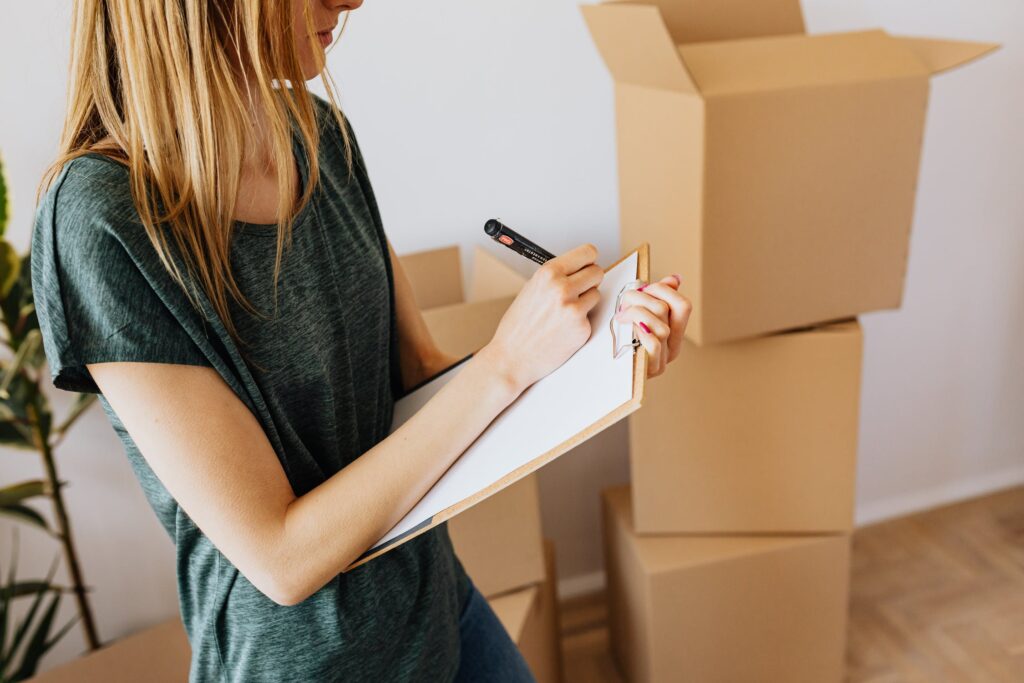
Jobs-to-do
- Declutter - book a visit to the tip and plan a trip to charity shops to get rid of all things you don’t need
- Collect boxes - post social request and ask friends for spare boxes or request from a supermarket
Admin-to-do
- Renters: give notice to your landlord
- Notify phone and internet providers about your change of address
- Plan temporary storage to help make your home more presentable for buyers. Visit Access Box Storage to begin this process
One month before the move checklist
Jobs-to-do
- Start packing spare bedroom and rarely used items
- Clean out and pack up the shed and garage
- Buy additional packaging you need
Admin-to-do

- Research and book a removal company – Checkatrade.com and comparemymove.com will show your best local options
- Research and book van rental – If you’re moving your own belongings
- Research and buy moving insurance to cover your belongings during transit if your removal company doesn’t provide
- Contact Royal Mail to organise post redirection
- Make an inventory of your belongings and take pictures of valuable items. You can check the pictures after the move to see if anything has been scratched or chipped
- Inform car, home and life insurance, council, doctor, friends and family of your moving date and new address
1-2 weeks before the move checklist
Jobs-to-do
- Start packing away non-essential/seasonal items that won’t be used in the next 2 weeks
- Plan and cook recipes that will use up all the food stored in the freezer
- Dismantle larger furniture that will not move in one piece
Admin-to-do
- If needed book the day off work or arrange childcare or pet care for the day of the move
- Research and book storage to store non-essential items you won’t need when you move into your home. Having more space allows you to better arrange your home
- Confirm location, date and time with the removal company. Arrange parking permits if needed
- Renters – schedule time for key handover and house inspection with your landlord
- Redirect your TV license to your new home address
1-2 days before the move checklist
Jobs-to-do
- Finish the packing – making sure to label the boxes with the room that they will be moving to in your new house
- Put the final load of washing on so that you’re not moving dirty clothing
- Pack important documents and valuables in a marked-up separate box so they’re not mixed with general belongings
- Pack an overnight bag so that you have everything you need for your first night and day in your new home
- Get the tools ready and disconnect all appliances that you’re taking with you and defrost your freezer
- Pick up the van if you’re moving your own belongings
Admin-to-do
- Re-arrange grocery delivery to your new home address
- Contact utility companies to let them know your moving and your new home address
Moving Day
Jobs-to-do
- Inform the removal company on the label instruction on your boxes
- Renters – take photos of each room as proof of the condition you left it in
- Enjoy the moment you’re moving to your new home
Admin-to-do
- Take the final meter reading
Your new home list

- You did it! Time to take a deep breath and give yourself a pat on the back.
- Unpack your first day bags so that you have the essentials in your bedroom, bathroom, and kitchen.
- No cooking for tonight: order your family favourite takeaway and enjoy your new home atmosphere.
Moving is a rite of passage in someone’s life that doesn’t have to be the way it’s conventionally portrayed. It’s a challenging process - this has to be said - but with the appropriate arrangements and the right mindset, you’ll be able to get through it smoothly.
Selecting and dividing are keywords. Therefore, cardboard boxes will be your number one allies! Moving simply isn’t possible without them.
Where to find and collect free cardboard boxes? There are many options, including:
- Local Supermarkets
- DIY stores
- Discount shops
- Food Restaurants
- Freecycle
- Local recycling centres
- Opting for Access Box Storage as your London moving & storage service
Free Cardboard Boxes: Ask at the supermarkets & stores
Where to get free cardboard boxes in London? Supermarkets and stores are some of the places where you can easily find and collect cardboard boxes for free.
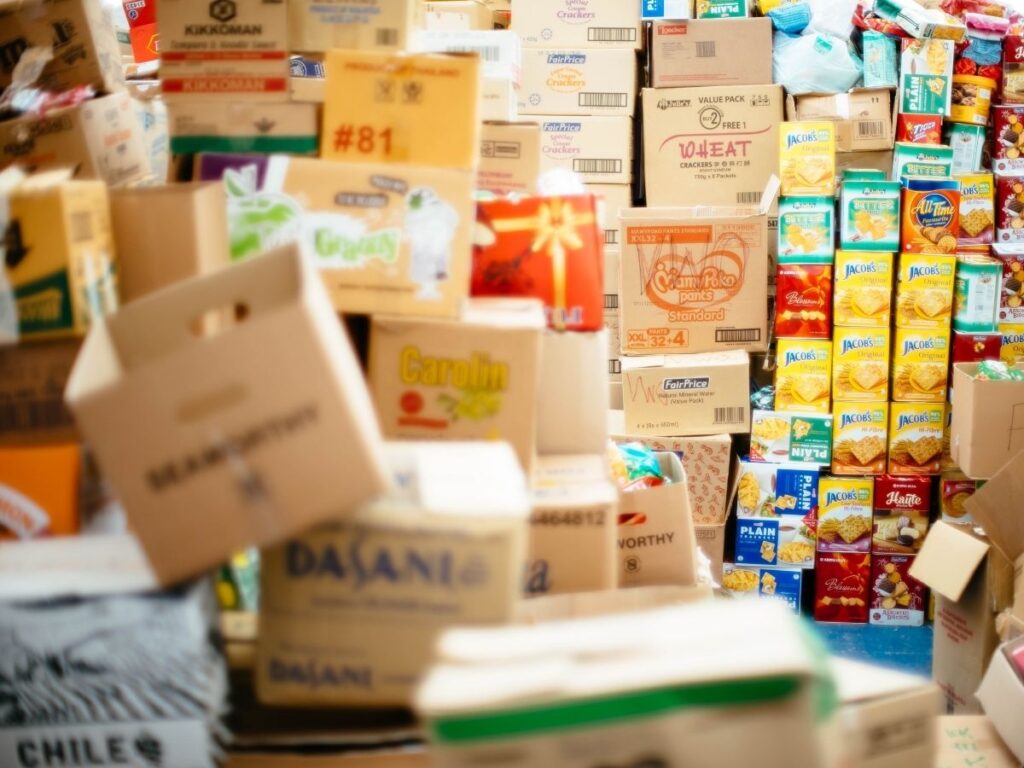
Supermarket stock is delivered on a daily basis to stores in cardboard boxes: you can ask if they have any large ones in good conditions for you to use.
Try to go to your local supermarket at a time you know won’t be busy, or ask when the next delivery will be and go then.
Boxes from local restaurants
All restaurants get stock delivered in cardboard boxes on a daily basis, so a little trip to your local restaurants can be worth a try. You might be lucky enough to find one really close to where you live.
If you’re a regular, they’ll be even more motivated to get rid of boxes they don’t need. Ensure the boxes don’t have any spillage and try to opt for boxes containing dry items.
Find free cardboard boxes at Freecycle
Freecycle gets you in touch with people who recently moved and don’t need their cardboard boxes anymore. It’s important to check that the boxes are in good condition, as they already endured one (or more) movings.
Local recycling centre

If they’re not re-used, this is where most cardboard boxes end up. You’ll find them flattened down, but they can be strengthened with packaging tape easily to return to their original shape. Just be careful again to look for boxes that are in good condition and clean.
Free boxes from Access Box Storage
Using second-hand cardboard boxes comes with the perk of saving money, but what if you could get new free boxes for free?
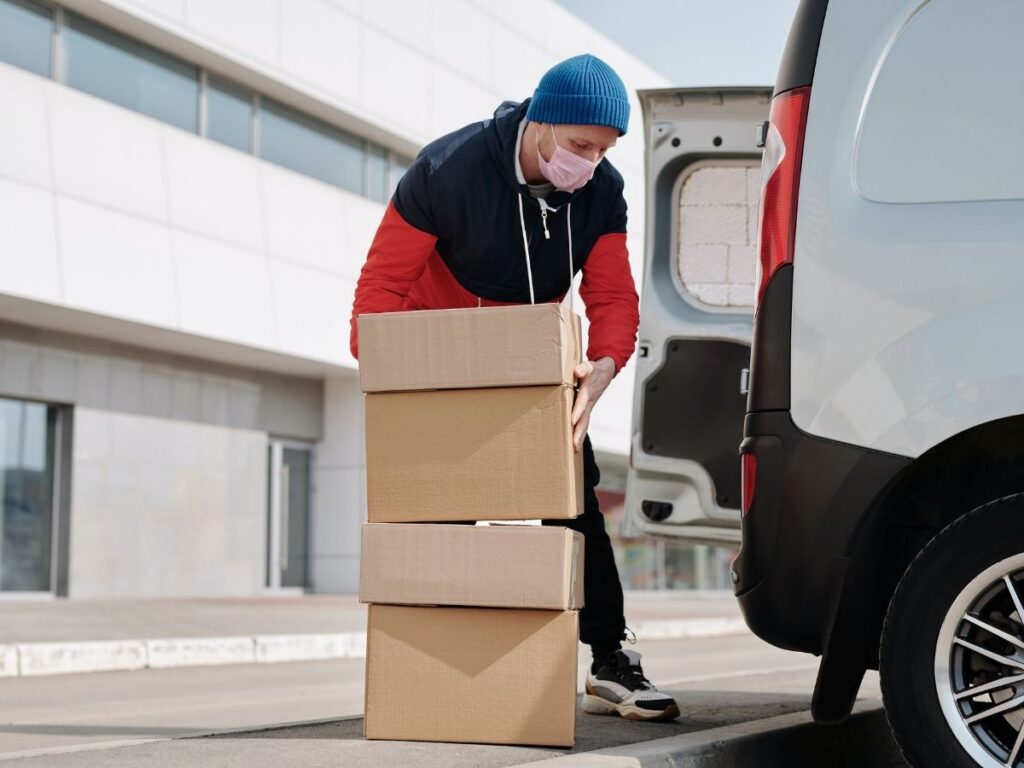
If you're moving around London, opting for Access Box Storage mean you'll be able to save money and preserve your items impeccably until they reach your new address.
When you place your storage order with us online, we will deliver your empty boxes (current special offer) to you at the time you have specified. You can schedule your full box collection up to 2 weeks after we have delivered you your empty boxes.
Using old boxes vs new boxes for moving
Whenever you can, always use new, sturdy boxes when you’re packing for storage!
Used ones could have dried spillage, which weakens the box & attracts ants and cockroaches. If you plan ahead, you’ll keep your belongings in boxes for a while, so you want to make sure they won’t be damaged once you open the boxes.
Extra tips: How to pack moving boxes properly?

If you’re wondering how to start packing boxes for moving and what to do, you landed in the right place. We’re sure these tips and tricks will help you.
- Start packing with the right materials and tools. Boxes, but also packing peanuts, bubble wrap, packing paper, tape, scissors, marker, ziplock bags for small items. You may also need to prep a box cutter in case you need to pop open a box that you’ve sealed.
- Choose proper boxes for moving. Avoid anything that once contained food and drinks. Old boxes are also less sturdy, so the safety of your stuff is compromised.
- Plan ahead with a list and schedule. Give yourself attainable goals, and the timetable to achieve them will ease your burdens. Doing this early will also give you a chance to declutter.
- Prep moving boxes. Don’t forget to line the bottom exterior with tape for an added layer of security. Pad the bottom of the interior: this serves as a shock-absorber in case someone drops the box.
- Fill the boxes properly. Try to mix your heavy items, like books, with a few lighter ones to stick to that weight limit. If you have space left to the top, add packing peanuts: the goal is to keep the top firm.
- Label the moving boxes. This is such a crucial step! Mark which room does a specific box belong to and make a rough list of contents.
Offices are far from over, and office storage ideas will soon come in handy more than ever. With the official government’s roadmap to begin easing lockdown in England from March 2021, we are carefully approaching a comeback to the office life.
The promising vaccine news is encouraging the return to work, but when that comes, the office won’t be the same again. What will that mean for the workplace? Most companies have adopted new ways of working that have left their offices relatively empty, and many office workers won’t grind out a full week 9 to 5 at their desk again.
We’re understandably apprehensive about returning to the office after such a long time, but we’re equally excited about having a glimpse of proper social interaction.

The increase in remote working will see businesses look to more flexible and relatively smaller workspaces. The days when a company would provide a desk station for each and every staff member are coming to an end: a trend that was already taking shape, but the pandemic has dramatically accelerated it.
What will this mean for employees, in practical terms? We’ll make more with less office space, and we’ll need to gradually adjust to this work-from-home/work-at-the-office hybrid. With offices relocating, you will need extra space and personalised storage solutions: some can be implemented immediately, often for very little or no money. We rounded up some tricks and tips for making your return to the office efficient and smooth!
Office wall storage ideas
Try to think of office storage ideas that are considering the space vertically. Making the most of all the space between your floor and ceiling can provide you with precious storage. Shelves are a great solution, together with wall mounted furniture, while wallboards are perfect for keeping your office tidy.

They’ll avoid having post-its and clutter all over your desk, which is pretty much everyone’s weak spot. There are also plenty of flexible storage solutions that can perfectly adapt to your office space and its walls. Whether you need to adapt to a corner or to an asymmetrical wall, modular furniture is sometimes a real space saver.
Office desk storage ideas
Finding the right desk can be key: opting for a foldable desk is such a functional choice. It folds up when you need it and folds down at the end of the day - taking very little space. You can also find a desk with drawers where you can keep all your stationery or add a complimentary storage caddy close to one of the desk’s legs, where you can store all of your office must-haves.
Keeping the desk tidy
Returning to the office is also a great occasion to reorganise your workstation and to make sure you’ll keep only what you truly need.

Decluttering will lead to fewer distractions and an overall sense of easier focus. With organisers and colour-coordinated dividers, you’ll know exactly where to look when you need something, and you won’t have to rummage through packed drawers along the way.
Get some storage space for a good price
Thought that the digital era would mean no more paper? It’s always very likely you’re surrounded not only with paperwork but also equipment, training materials and more. You need to store all of this while keeping your office looking professional. However, additional storage needs additional room, which isn’t always accessible. So what’s the best solution?

Once you have an accurate idea of what needs to be in your office on a daily basis, you won’t see the point in keeping close to you items that are equally important but you will hardly need to have at hand.
Archives, documents, paper records, contracts and so on: why shrinking your precious space for those? Fortunately, there are budget-friendly and hassle-free solutions to make your office space an airy and versatile working spot.
All the benefits of choosing Access Box Storage
If you need a reliable and efficient service that collects and stores your items until you need them back, then box storage is a perfect solution.
With Access Box Storage, you’ll get free storage boxes and a free courier collection, which will pick up your boxes (or larger items that don’t fit in a box) right at your office.
Our storage service is budget-friendly, with a pretty unbeatable price of £7.50 per box per month.
You’re worrying that having documents stored out of your office will make them inaccessible when needed?
Do not worry, as if you need anything back to the office again, Access Box can deliver boxes or just selected items back to you whenever required.
You can rest assured that all your belongings are in safe hands: the storage is safe with CCTV 24x7 surveillance. Whenever and in any way you’ll be back to the office, make sure you’ll feel safe, comfortable and efficient!
It’s true to say that in moving to a big city like London, you have access to many more opportunities. But, pretty soon, whether you're a student, a renter, a homeowner or a shop owner there’s one constant challenge and that’s a lack of space.
Whether you're renting a flat, paying off a mortgage or pay rent on a shop, you know that buying additional space in London will cost you a fortune.

Luckily, there’s an affordable solution to making space. By storing belongings, furniture or stock you don’t currently need you instantly free up and make better use of your existing space.
Storage prices in London vary because there are different types of storage services available to you.
As you would expect, self-storage prices are nearly double in London compared to other bigger cities in the UK, like Glasgow, Birmingham and Nottingham.
Storage prices in London also differ, depending on:
- What type of storage service you need
- The amount of space you need
- What company you choose
- What access you need to the items you store
What type of storage service do you need?
There are several types of storage services you can find in London:
Outdoor storage in London
Outdoor storage options are exactly that, they are open, guarded areas. Many of them are a combination of guarded car parks (for camping trailers or boats) and shipping containers in which you store your belongings inside.
Shipping containers range from 6 to 45 feet in length, creating spaces of 56 to 320 sq. ft., large enough to store the contents of a 6-bedroom house or 12 office desks. The cost of renting a shipping container is £425 plus VAT per month.
Self-storage in London
Self-storage provides space for individuals to rent and store their personal or business belongings. The storage space rented will be a locker or a unit. Lockers are up to 10sq. ft and units are typically from 15 to 400 sq. ft. The individual will take and pack the unit with their belongings. They’ll have access to the unit during store opening hours and may have access after-hours as well. When they’re finished with the storage unit, they’ll then remove their goods.
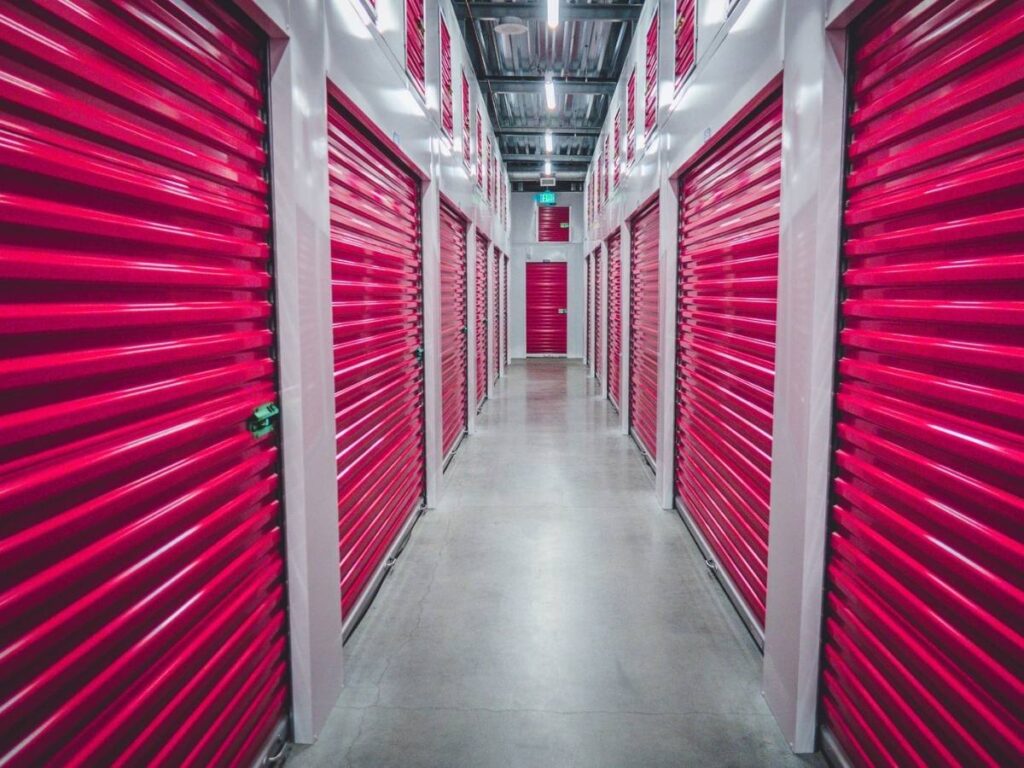
Self-storage price in London
Unit rental prices, depending on the space you need and the location of the unit. Most units are charged a standard rental charge however units closer to the lift, store exit and car park are charged as premium units.
Renting a 20 sq. ft standard storage unit in London: £44 - £64 a month
Renting a 35 sq. ft. standard storage unit in London: £64 - £92 a month
Renting a 50 sq. ft. standard storage unit in London: £92 - £120 a month
But, when looking for self-storage, don't focus solely on the price:
- Check online for which unit sizes are available as you don’t want too big or small
- Visit and check the security of the site and units
- Assess the location and the time you’ll need to travel to it
- Read the Google My Business reviews the store has gained
- See what additional packaging deals are available
- Be clear on any late payment policies
Storage by the box
Storage by the box is a new concept, and it's very different from the self-storage model.
The most significant difference is, you don't buy storage space, you pay for storing boxes that you’ve packed yourself.

Also, in storage by the box, you don't have to transport anything to the storage location. Free empty boxes are delivered to you, you pack them with your belongings and then the storage provider collects them from your doorstep. When you need the boxes back they deliver back to either the London pick-up address or another London address you choose.
Empty boxes, box delivery, box collection plus box protection are all included in the price.
The price for storing a box with a weight limit of 25 kilos is just £5.50 per box per month, but you can also store larger items for which you pay a little more.
When storing for a longer time in this model, you get a discounted price. For example, if you leave your boxes stored for more than 12 months, the price per box lowers to £4.40 per box per month.
Self-storage or storage by the box?
You may be confused about which storage option is right for you. We'll try to help you choose.
How much does storage cost?
The cheapest self-storage by square foot you can find costs £44 a month. A box is £5.50 a month. So, you can store eight boxes per month for the same price as renting the cheapest 20 sq. ft. unit. Eight boxes give you 200 kilos of storage.
Work out how much weight you need to store to help you save money.
Can you transport the items?
If you use self-storage you’ll either need to own, or rent a car, to get your belongings to and from the storage facility.

As for storage by the box, the empty boxes are delivered to you. You pack the boxes with your belongings and the storage provides collects them from your ground floor door. There’s no need to ever visit the storage facility.
Your Next Step
Compare the storage market with the knowledge that box storage is cheap, hassle-free and doesn’t need you to provide transport and self-storage is better for larger volumes where you do manage the transportation.
Whether you’re downsizing, streamlining or finally getting round to redecorating ‘that’ room; sometimes we find that we no longer have a place for the things that once made a place our own.
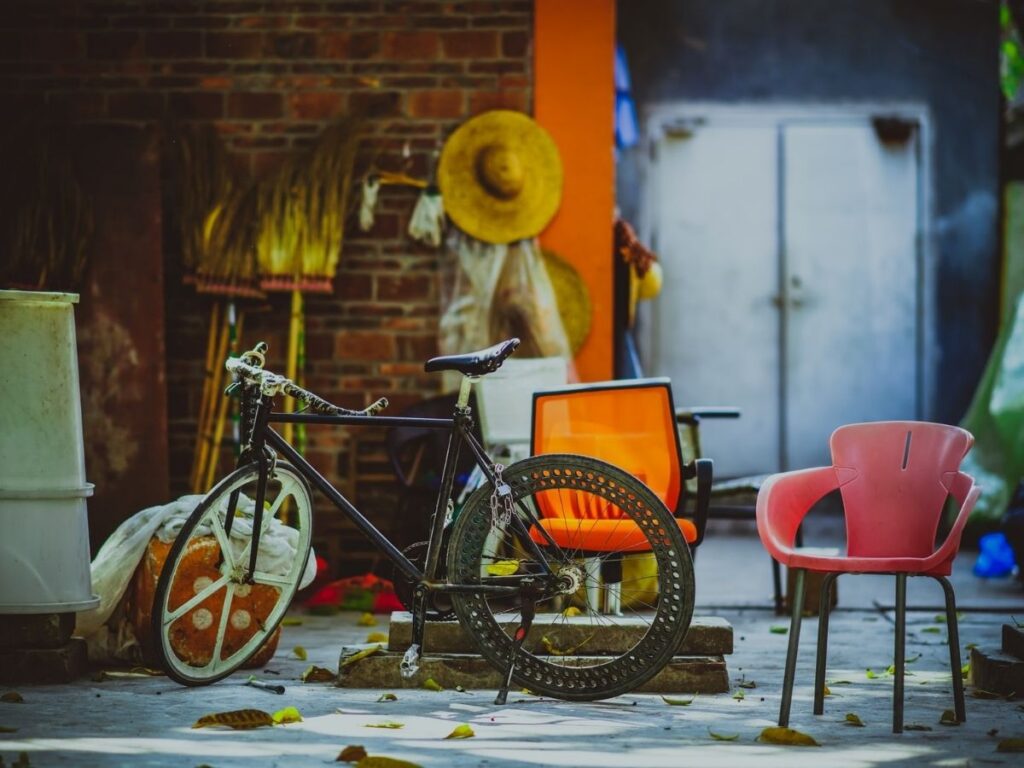
Getting rid of furniture feels like it should be an expensive process. Luckily for us in London, there are a number of ways we can get rid of unwanted furniture for free that are both easily accessible and eco-friendly.
If you're trying to get rid of unwanted furniture for free, you can:
- Try to leave your furniture outside
- Take it to the recycling centre
- Donate it to charity
- Sell it for a low price
We’ve thought of all of the possibilities and considered its pros&cons. Hope you'll find at least one of them useful.
Option #1: Leave your unwanted furniture outside
When we have to get rid of furniture, the first thing we think of is to do the easiest thing and just put it out on the curb in the hope that someone walking past will take a fancy to it.
Whilst this is no doubt the easiest option, there are a few things you need to consider before leaving your stuff out for the curb miners.
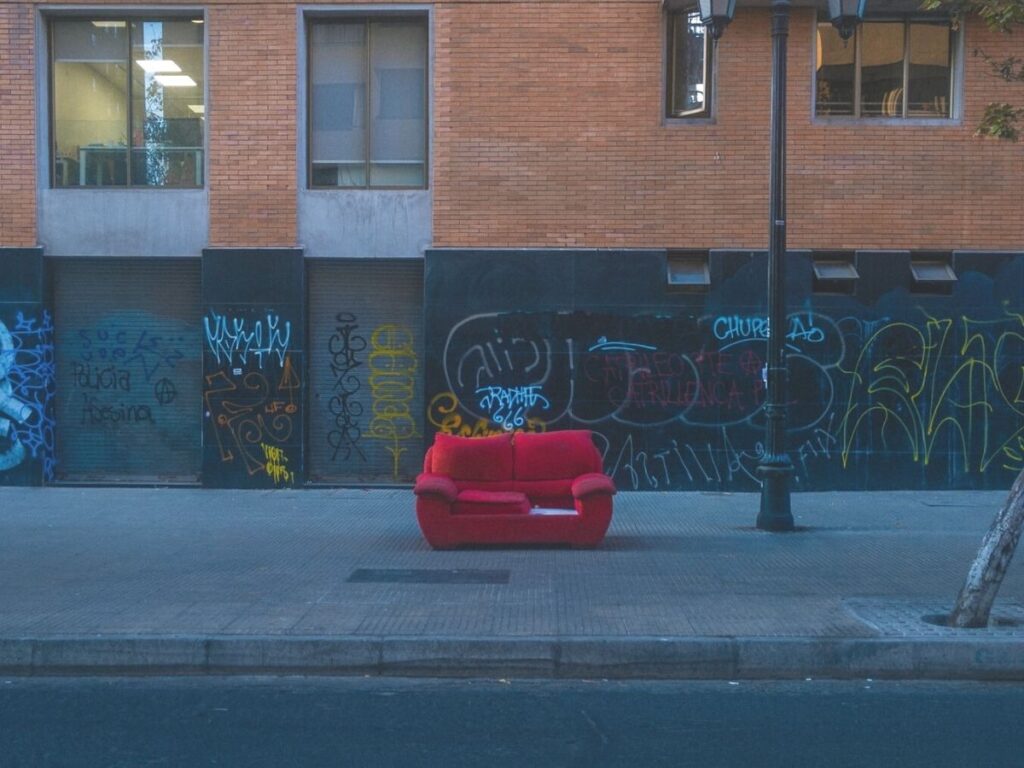
Firstly, leaving furniture on the street can be considered fly-tipping and you could receive a fine. There is no London wide policy on what fines can be served for fly-tipping and every borough is different. For example, in Kensington and Chelsea fines start from £150, but across town, in Lewisham, the lowest you can get is £250. The risk of a fine becomes more likely if you leave your stuff out in bad weather, it’s a particularly large item such as a sofa, or if you live on a quiet street.
Secondly, the site of an unwanted pile of furniture on the street could do little to help your standing in the community. You should consider your neighbours before placing your personal items in a public space, especially if you live in an apartment block or on a narrow street.
Generally speaking, if the items are good quality and small enough to carry, they will be picked up relatively quickly and you would be unlucky to face any fines. However, if you’ve got larger items, you should probably consider alternatives.
Option #2: Taking Furniture to the Recycling Centre
If you’re looking to pass multiple items on in one go then a trip to your local recycling centre could be the way to go.
Most tips now have dedicated recycling areas where people can leave unwanted furniture free of charge for others to pick up.
Most London boroughs have their own recycling centre that can be found through the local authority’s website. Unfortunately, once again, every borough is different so make sure you look up your local facilities rules on things such as bringing ID, the amount of waste you can bring and if there are any items they don’t accept.
If you don’t have your own transport, getting your furniture to the centre could prove a problem. Renting a van can be costly, so it may be worth checking out your local council’s bulky waste collection service. A handful of boroughs offer this service for free but most charge between £10 and £40 for multiple items.
Option #3: Get rid of unwanted furniture for free by donating it to charity
Many charity shops have some kind of furniture business where good quality donations are always welcome. This makes them a great option if you need to lose some furniture but can’t stand to see it go to waste.
The bonus with this option is that your unwanted furniture goes towards raising money for worthwhile causes whilst also standing a good chance of finding a loving home.
The British Heart Foundation and Sue Ryder are the biggest charity furniture retailers and both have shops dotted throughout London. BHF also offers free collections but availability can be tight, especially during the lockdown.
Again, it’s also worth checking with your council to see if they offer a charity donation service – it’s surprising how many do.
Option #4: Selling for a low price
Now, we all love a bargain but unfortunately, we’re all familiar with the phrase ‘too good to be true’.
Every time we see something advertised for free, a little voice in the back of our head asks us ‘what’s the catch?’ This can make giving your stuff away on sites like Gumtree and Facebook harder than you thought.
Instead, try sticking a token fee on to attract attention. A table that is given away for free definitely has a wobbly leg, but a table being sold for £20 is too good to miss.
Maybe you need some extra space?
Are you in between the moves? Or are you redecorating and you have some things to tuck away? If there's some furniture you're still holding on to, you might need some extra space temporarily.
If this is the case then it has never been easier to store small numbers of items at an affordable price for as long or short as you need. Access Box Storage offers the option to store items by the box or individually, meaning you might not have to say goodbye to that vintage lamp or favourite armchair after all!
This temporary storage solution is a really convenient one for anybody living in London. You just have to book the service. New boxes are then delivered to you for free, and pick-up is also included in the price.
Discover the details how it works and help yourself out!
Are you wondering what to do with those extra chairs or the sofa that's in the way?
Furniture storage can be tricky; there is more to it than you would think. Fortunately, we know a bit about storing stuff, being in the business for some time.
When do you need furniture storage?
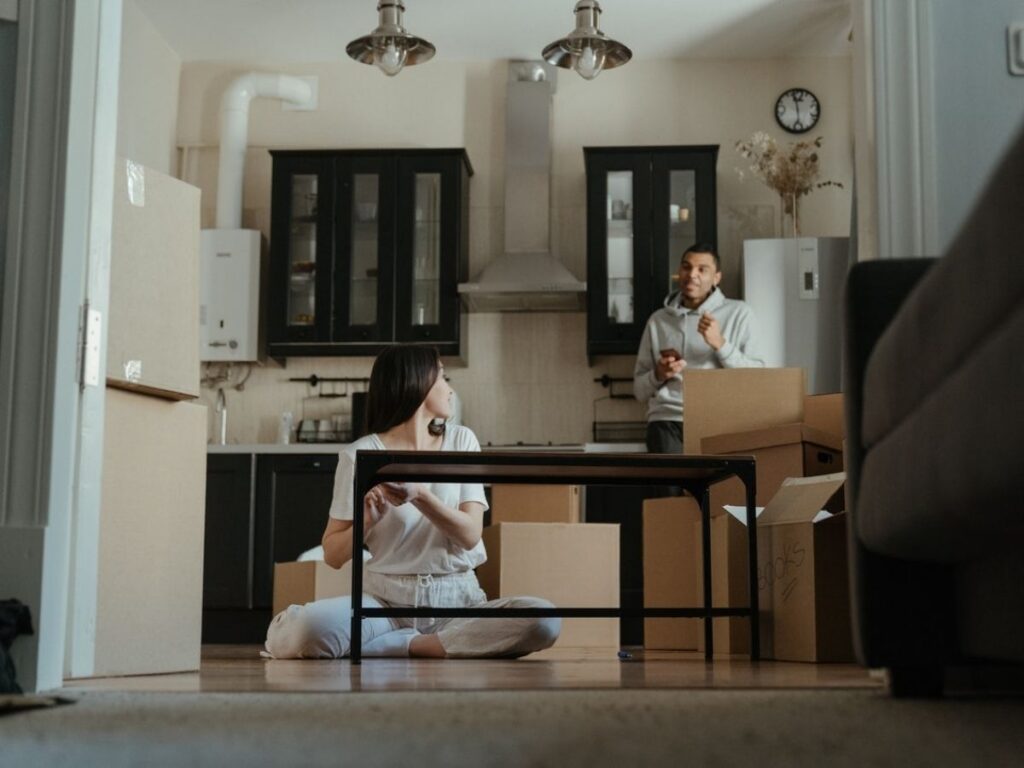
You would think that you don't need some furniture storage as you have just the right amount of pieces for your living space.
But, there are times when you'll really need to allocate some pieces in temporary storage:
- Furniture can get in your way when you're redecorating.
- The extra chairs for guests that take up the room.
- You're moving from one address to another.
- Renting your appartment (but without your furniture).
Additionally, furniture storage can also come in handy during the winter season. As the colder months start to approach, your outdoor and garden furniture become susceptible to external elements. If you do not have space in your garage or a shed to keep your furniture protected, placing garden furniture in a storage unit will ensure they stay pristine throughout the season.
How to choose the right type of storage?
Once you decide that you need storage, you can then find an appropriate place. Typically, your garage, basement, or attic may be good choices.
But, if you're living in London, you don't have that extra room. In that case, the ideal option will be to rent a storage unit. To help you determine the right storage for your furniture, try to answer these questions:
- How many pieces of furniture do you need to store?
- How long do you have to store the furniture?
- Do you have transport?
- How much does furniture storage cost?
How many pieces of furniture do you need to store?
First, determine how much furniture you plan to store. This will tell you how much storage space you need. If you only need to take away one or two furniture pieces, you can opt for storage that charges storing by piece, like us at Access Box Storage.
However, if you have enough furniture to fill a room, you should opt for self-storage.
How long do you need to store your furniture?
Another thing to consider is for how long you need furniture storage. If you're planning to undertake major renovation in your home, it can take a few months.
A little less time if you're between moves.
Some storage companies, like Access Box Storage, will offer you a discount for longer-term storage, bare that in mind.
Do you have transportation?

Finally, transportation may also be a concern when storing your furniture. Companies like Access Box Storage offer pick-up services to collect your furniture, as well as delivery services to return them when you need them back. This can some really convenient as you don't have to transport it around town by yourself.
How much does furniture storage cost?
The self storage option allows you to rent a room that cost from £11 - £16 a week in London (for 20 square feet). Plus, you have to bring everything there yourself
A much better version if you have just a few pieces of furniture lying around is Access Box Storage. Every piece has it's own price, you can check it after entering your postcode on the homepage.
A price for a chair for a month is £11 while storing a mirror is £5 a month. It's easy to calculate your expenses.
Don't forget! Prepare the furniture for storage
Don't forget to prepare the furniture for storage! Clean each piece thoroughly to prevent dust and odours from accumulating, then proceed to disassemble your furniture pieces (if you can).
Taking them apart will make packing and storage much easier, but make sure you place the smaller parts in a labelled bag to avoid losing them.
Before you place your furniture in the unit, you will also need to wrap them properly, keeping all sides and corners covered. Bubble wrap works well for wood furniture, while covers and blankets are more suitable for leather and upholstered furniture. Be careful not to use plastic covers that can seal moisture since this will cause mould to build up.
That's it! Start storing!
Should I throw this away? Maybe I'll use it for something.
Were you ever in this dilemma?
You probably were, it's normal. You know the feeling that comes to it, right? Now, imagine having it every single time you want to get rid of something. There are no moments of clarity when you clear everything, just the feeling of keeping on to something.
That's hoarding, and it's a psychological disorder. In fact, it's classified under anxiety disorders, and it's complex and serious just as an eating disorder.
According to Help for Hoarders UK, there are over 1.2 million people in the UK who suffer from it, which is approximately 2-5% of the population.
It's not easy to overcome this, but there is a way. The first thing that needs to be done is admitting the problem and getting psychological help.
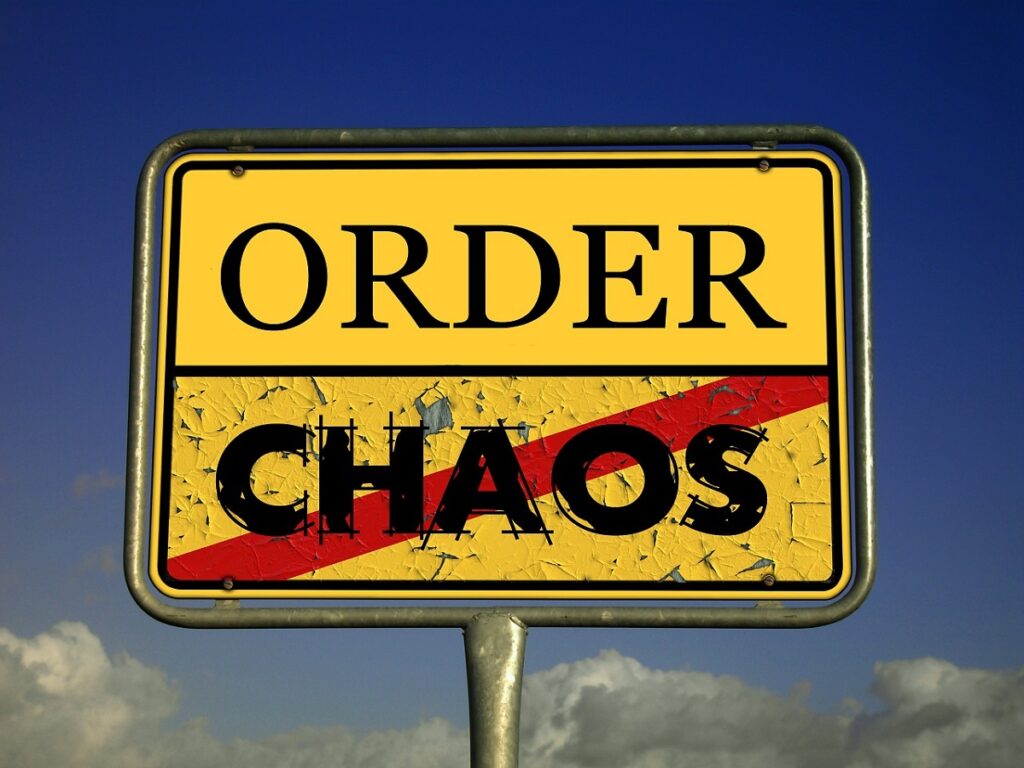
Along with emotional support, people suffering from hoarding also need help with organising.
Professional organisers & declutterers Sally Ryan (Love2Declutter) and Mimi Bogelund (The Organised Home and Life) shared their experiences with us.
Decluttering tips for hoarders
1. Create categories and subcategories
Mimi points out that having a plan is a starting point. - However hard it may be, trying to work methodically, in specific categories and subcategories can help. Start with what you find easiest.
-You might feel ready to let the paper go, so tackle the subcategories: magazines, newspapers and flyers that were piled up - explains Mimi.
2. Start with small areas
Sally suggests starting with small areas.
- It can be a small drawer, a handbag or just a magazine pile. Deal with each item, one by one. Only clear that one small space and congratulate yourself on what you have achieved, don't beat yourself up about what you have yet to do - says Sally.
3. Make a schedule to make a habit
Creating a schedule with clear goals and sticking to it is another good technique for clearing the space.
- Give yourself a goal of one, two or three items a day with weekends off. Again, pat yourself on the back for decluttering your chosen number of items and don't stress about what is still to do. Decluttering is a habit and takes practice - recommends Sally.
4. Room by room
When you feel ready, try to clean out a whole room. Start with your bathroom. Tell yourself over and over again that keeping old pills can be really harmful. Toss away any personal care products you have over a year. When you're finished with the bathroom, move to the next easiest room.
5. Organise the throwing away part
Decluttering isn't just about clearing one drawer or one room and moving the clutter to another part of your home.
You can't just toss everything in front of your house, or stash the garbage in the backyard as you will most probably find yourself returning some of the items.
Ideally, says Sally, you can do the following with the waste:
- Good quality items: give away to charity.
- Share the sentimental family items with your family and relatives.
- Recycle paper, plastic, metal.
- Sell on Freegle/Freecycle or other pre-loved marketplaces; or sell on a car boot sale (of course, once these lockdowns stop).
6. Box the stuff you still can't throw away

Once you get to that phase that you cleared a lot, but you're still uncertain about some things, box them. But limit the number of that boxes to a maximum of three.
Don't tuck them somewhere in your pantry, shed or attic.
Move them to a storage facility, somewhere out of your sight. After a year passes, if you didn't need any of the items in those boxes, you should get rid of them. How? Like we explained.
7. One in, other out
After you finally clear out the clutter, it will be tough to keep it that way. So, try to stick to a simple rule: One in, other out.
For example, if you buy new jeans, throw one. That will keep your mind and your things in order. Try to be a minimalist with clothing.
Always ask for help
A lot can trigger the hoarding disorder, and as people are different, so are their collecting habits.
From Mimi's experience, collected items are rarely something practical.
- Items that hoarders collect vary hugely from each individual and rarely have anything to do with monetary value or practical use - says Mimi.
People can pile anything, magazines, books, toy cars, video cassettes, old cables, shampoo bottles... The important thing is that they shouldn't be judged.
If you have a problem with your clutter, always remember to go back to the first step - ask for psychological help.
.
We're sorry, we don't want to sound grinchy, but it's time to say goodbye to Christmas. Just look at your Christmas tree. The poor thing doesn't have any needles on it anymore.
If the tree's sad look isn't reason enough, maybe the fact that everyone is removing it is. Since the Victorian Era, people across the UK are removing decorations on the Twelfth Night of Christmas.

That info can be confusing as some consider January 5 as that day while some think its January 6 as it's the 12th day after Christmas.
January 6 is the Epiphany, the day when the Three Kings came to baby Jesus with gifts, guided by the star.
Whatever day you pick for storing Christmas decoration, that's absolutely fine (although the superstition says you'll have bad luck if you don't take it off on the right date).
Superstitious or not, the best way to store your Christmas decorations is to store it so you can use all of them next year.
Basic tips for storing Christmas decorations
- Sort everything - Christmas baubles, lights, and whatever else you might have.
- Clean the ornaments from artificial snow if there is any.
- Remove batteries from any lights or ornament you might have.
- Use transparent plastic bags for storing plastic baubles.
- For fragile Christmas ornaments, you can use old egg cardboard boxes to store them.
- When putting ornaments in a box, use bubble wrap or tissue paper to avoid damage.
- Label everything.
- Store them in a dry place to prevent mould from appearing on the decorations.
Your Chrismas decorations should be perfectly fine when you store them like that, but we have more insights on storing the festive stuff.
How to store Christmas lights?
Store your Christmas lights separately from other ornaments. There are two reasons to do so:
- You can use your Christmas lights for any party you will be organising, especially if your Christmas lights are outdoors. Summer evening garden parties look really nice decorated with tiny lights.
- Lights are electronics, and storing electronic devices has its own rules and principles.

Whenever you'll use the lights again, whether it's the garden party you don't want to occupy yourself with detangling. It's the worst-case scenario, and it can ruin your decorating mojo.
To be sure you've done everything right:
- Remove the batteries from your Christmas lights if there are any.
- Check if all the light bulbs are working and try to fix them by twisting or wiggling them.
- Wind them up. It's vital to wind the lights neatly, so they are ready for use when you unbox them.
You probably got a plastic winder with the light which you probably threw away. So, find a coat hanger or a piece of cardboard and wrap the lights around it. Wrap the lights around it neatly, and you're ready for the next season. Of course, use a separate piece of cardboard or a coat hanger for every Christmas light.
- Put the lights in a cardboard box, add some newspapers bubble wrap in between.
- Store in a dry place.
Store your artificial Christmas tree like this
Having an artificial Christmas tree has its benefits - the needles don't fall off and, even though it's made out of plastic, you can use it again and again.
If you want to make a positive impact on the environment, environmental experts say, you have to use it for, at least, 10 years.
But to use it for a decade and more you have to store it with care, so it resembles the tree you picked up at the store.
1. Remove the sections first, unplugging them one by one and gently laying them on the floor.
2. Gently clean the dust off. Make sure that everything is dry.
3. Fold up the branches, so they are pointed upward.
4. If you don't have a bag or a plastic container take some plastic wrap (the kitchen one will do) and put it around the folded branches. That way you secure it.
5. Store your tree in a dry place. Even though it's plastic, it can get a mouldy smell if stored in a damp place. You really don't want your magical Christmas tree to smell like an old basement once you open it up next year.
Where to put your Christmas decoration?
When you live in a big house with a big garage, you don't ask yourself that question. If you live in London, you're one of the lucky people who have space, and you can put it in your attic or shed. Most of us live in apartments.
The most important thing is to put your Christmas decoration and the tree in a dry place or protect it from moisture.
Try to move the boxes under the bed or deep in the pantry, where you don't usually go in.
When the bauble box becomes yet another annoying box that you trip over, it's time to send it to storage.
Access Box Storage can pick it up whenever you want & we'll return it right before your next Christmas. It's hassle-free storage.

Having a clean and neat home can be one of the most satisfying feelings, but finding the time and motivation to clean up is not always the easiest. Over time, your things naturally accumulate, piling up until you notice how many things you have in your home.
At one point, you may get sick of seeing the mess and the extra or unwanted items lying around in different parts of your place. When this happens, it may be time to declutter your house.
Decluttering may not be the most exciting thing to do, but the thing about this task is that if you don’t do it now, the chances are you won’t do it.
Thus, pushing yourself to get to the task at hand will be the best way to ensure you can accomplish it.
Fortunately, it’s possible to finish this in one day. Decluttering may sound like a time-consuming activity, but with the tips below, you will learn more about how to declutter your house in one day.
Make a house decluttering plan
Before you get to work, start by creating a home decluttering plan.

Having a plan beforehand can ensure you maximize your time and use it efficiently. To declutter your home, start by designating a space to put all the unused items that you plan to sell or donate.
One of the most common techniques is to go from room to room, so you do not feel overwhelmed or mix things up. This is essentially the divide and conquer approach, which is also often considered the most efficient since you concentrate on one area at a time.
Another way to approach your decluttering plan is the KonMari method, popularized by Marie Kondo, where you “divide and conquer” by category, rather than by location.
The order starts with clothes, followed by books, papers, miscellaneous goods, then mementoes. There is no answer as to what method is better, so the important thing is to find what works best for you.
As you go through each room, it will help to make an inventory of your belongings. List down all your items per room, then mark each of them under Keep, Throw, Sell, or Donate. This way, you can have an organized system and checklist to go back to if you are looking for a particular thing.
When In doubt, ask these questions
If you’re not sure how to declutter your home or where to begin, an effective way to breeze through the process is to ask questions. One of the most challenging parts about decluttering is determining what to do with some items, especially if you feel conflicted about keeping or getting rid of them.

For some, the answer may come quick and easy, but for others, it may not be as clear.
When in doubt, ask these questions the next time you pick up an item:
- Do I use it? If I do, how often do I use it or when was the last time I used it?
- Do I have something similar that serves the same purpose?
- Do I truly love it? Does the item hold irreplaceable sentimental value?
- Is this something I can borrow instead?
- Can I move these to a reliable box storage space in my area and make space for items I truly need in my home?
- Would I rebuy this item or recommend it to someone?
- Do I have another one of these?
There is no hard rule to decluttering as there are truly many ways to go about it, but the key is to take the first step. The thought of rummaging through tons of things may not sound like the best way to spend your time, but once you see the effects of cleaning your home, you may just be convinced. By having a proper plan and organized system, you can get the job done in a day.

Storing your electronics temporarily can be a good idea, especially if you're renovating your city home or getting away for a while.
We don't want to sound like we don't trust people, but leaving gadgets and electronics unprotected could make them not just disappear but also - get damaged.
If you're leaving the city for a while, your appartment could get broken into, especially if you live in an unsafe part of London.
When you find yourself in those scenarios, it's much safer to store your gadgets in storage.
Before you do so, read a few tips on how to store electronic devices properly.
Can you put electronics in storage?
The first question you may have is: Can you put electronics in storage? The answer to this is yes, you certainly can!
However, before placing any type of electronic device in a storage unit, you must prepare them carefully to ensure that they stay protected while stored.
Having a climate-controlled environment is crucial in storing electronic devices as the wrong temperature, and humidity levels can damage your possessions (a shed or a garage aren't a good choice).
First, electronics must not get mixed with water, so your storage unit must have controlled humidity levels to prevent moisture from seeping into your devices. Second, the storage facility must not be too hot or cold and must maintain optimum temperature levels of about 50 to 80 degrees throughout.

If you have old electronics laying around and not being used, the best thing you can do is recycle them. However, if you still plan to use them, but not for the time being, it will be useful to keep them in a storage unit while they are not in use.
How to store electronics in storage?
Preparing your devices for storage is important to keep them intact and in good condition, especially if you plan to keep them in storage for a long time.
- Clean your electronics
Like how you would prepare any other item for storage, start by cleaning all your electronics thoroughly, use a cloth to wipe off any dust, making sure to reach the crevices and circuit. Doing this will not only help keep your electronics clean but also give you an idea of their current condition, so you know if there is any damage to them once you inspect your storage unit. - Disassemble and take out batteries
Removing your electronics' batteries is important if you will not be using them for some time to prevent leaking and preserve the battery. If there is anything else you can dismantle from the device, make sure to do so and organize all the components together, so nothing is lost while in storage.
Whether it be electronic parts, cords, wires or other things, make sure you take inventory of everything you have for each device. This way, you can easily determine if anything goes missing after checking your storage unit. - Pack in original boxes
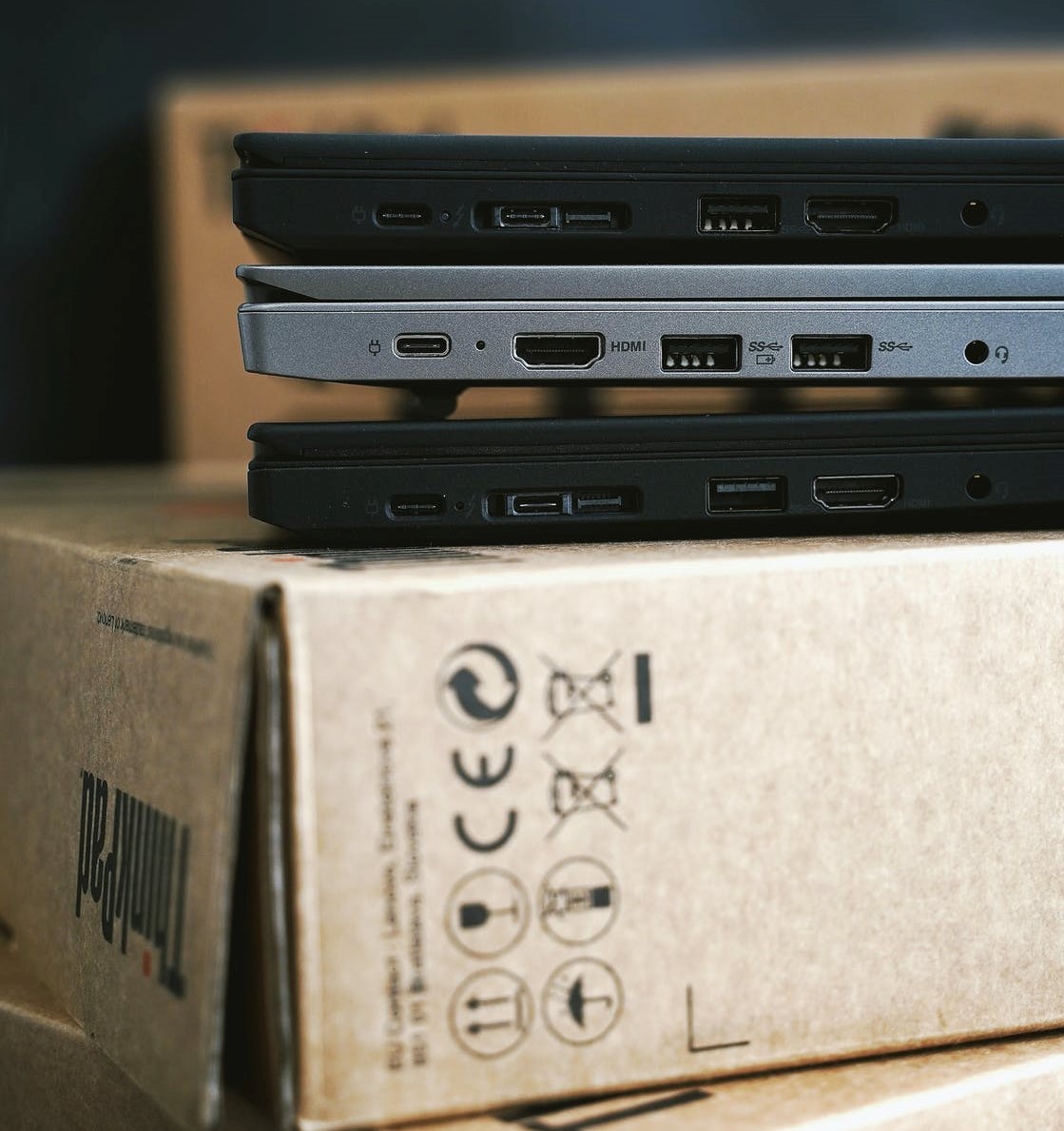
Once your electronics are ready, pack them in their original boxes, if possible. The original packaging is most ideal since your device will fit perfectly into it and often has anti-static material to prevent the device from breaking while in transit. If you no longer have them, you can pack them in a similar-sized box and wrap it with bubble wrap and other packaging materials.
Do electronics go bad in storage?
A common question that many people may have is: Do electronics go bad in storage? Say, you have an old television lying around in your apartment, and you want to store it temporarily for some time.
You might be wondering: Is it safe to store a TV in a storage unit? Electronic devices tend to be significant investments, so naturally, you may be concerned about what will happen to them when kept in a storage unit for a longer time.
Fortunately, if you choose a reliable storage company that has the proper facility and prepare your electronics carefully, you can rest assured that your devices will stay safe in storage.
For example, with Box Storage, the process is straightforward and easy. All you have to do is type in your postcode, and you will get an overview of the rates based on the number of boxes, length of storage, and add-ons like protection plans.
Once you're done filling out your booking details, then these will be picked up from your home on your specified date and time. Your items will all be stored in a secure facility with 24/7 monitoring to ensure safety.
Should you need to get your things back at any time, you can easily schedule a return date through your online account.
Whether you need a few or all of your boxes back, you can specify these and have your items delivered back to you in no time!
The year 2020. isn't a year anybody will remember by their backpacking through Europe adventures or business trips. It will be remembered, though, by bad DIY haircuts and home improvements.
Given that travel has been put to a halt, you may likely find your suitcases and duffle bags collecting dust.
If you live in a small apartment, finding where to store suitcases might be, at least, freeing yourself from the painful reminder of how you can't go anywhere.
Also, having some creative ideas on how to use your suitcases can free some space.
5 storage ideas for your suitcases
- Under the Bed or Couch
The area under your bed or couch is a hidden but golden storage spot that you can use to store virtually anything. If they are high enough, you will likely be able to squeeze in your suitcase or travel bags under your bed or couch, and you are good to go! - In the closet
Another common option is to store your suitcase inside the closet. More specifically, try to see if you have any dead space there. The top area is often left untouched or unused since it is too high to reach and thus impractical for clothes and accessories. However, for suitcases, you only use them occasionally, so placing them in that area will be perfect for times when they are not in use. - Behind the curtain
The area behind the curtain is one of the most overlooked spaces, but another hidden spot where you can tuck in your luggage. - On a hook on the wall
If you have free space in your wall, especially in the higher part of your wall, you can install a peg or hook and hang your suitcase up there. It can be easy to get caught up thinking about where to store suitcases that you forget that you can utilize wall space. - Behind furniture
Similar to the area behind the curtain, you can also make some space behind furniture pieces for your suitcase. You never know, there could be tons of hidden space that are left unused in those areas.
Use your suitcase as a storage unit
If you're still pondering about where to store suitcases in your small apartment, why not start by storing some items inside the suitcase itself? This way, you can empty some of your belongings and have more space to keep your actual luggage.

- Tuck away seasonal clothing
Your suitcase is the perfect place to store seasonal clothing. After all, you will most likely not be wearing clothes for a different season at a particular time, so placing them in your luggage can be a huge space-saver. - Store extra bedding
Bedding can be quite bulky and thick, so storing them in your cabinets can take up much space. By placing extra bedding in your suitcase, you can free up tons of space and instead use the space that was initially for your bedding to keep your luggage. - Keep anything you don't need
Generally, your suitcase serves as a storage unit in itself, so you can use it to store anything that you are not currently using.
If you still don't find any space for your suitcases and travel bags, you can always put it in temporary box storage. We can help you out, as we can pick them up at your front door and deliver them back once you start travelling.

Packing your stuff may sound like a trivial matter, but in truth, it’s not that easy. You can’t just tuck everything into boxes & close them.
We mean you can, but it’s not realistic to expect that your items will be intact in transport.
Your things will be whole if you use the right packaging materials and packing methods. Also if you know how to pack boxes for moving correctly.
For a never packer, buying the materials can be somewhat confusing. After all, you don’t do it every day.
You surely know about bubble wrap and it’s addictive popping characteristic, but what about other packaging materials (that are not as exciting)?
We’ll explain it now as knowing when and how to use each one can ensure your items stay intact while in transit.
What do I need for packaging?
- Bubble Wrap
Bubble wrap usually comes in rolls that you can easily tear when you need it. It’s the top material choice for more delicate and fragile items since they provide cushioning and protection.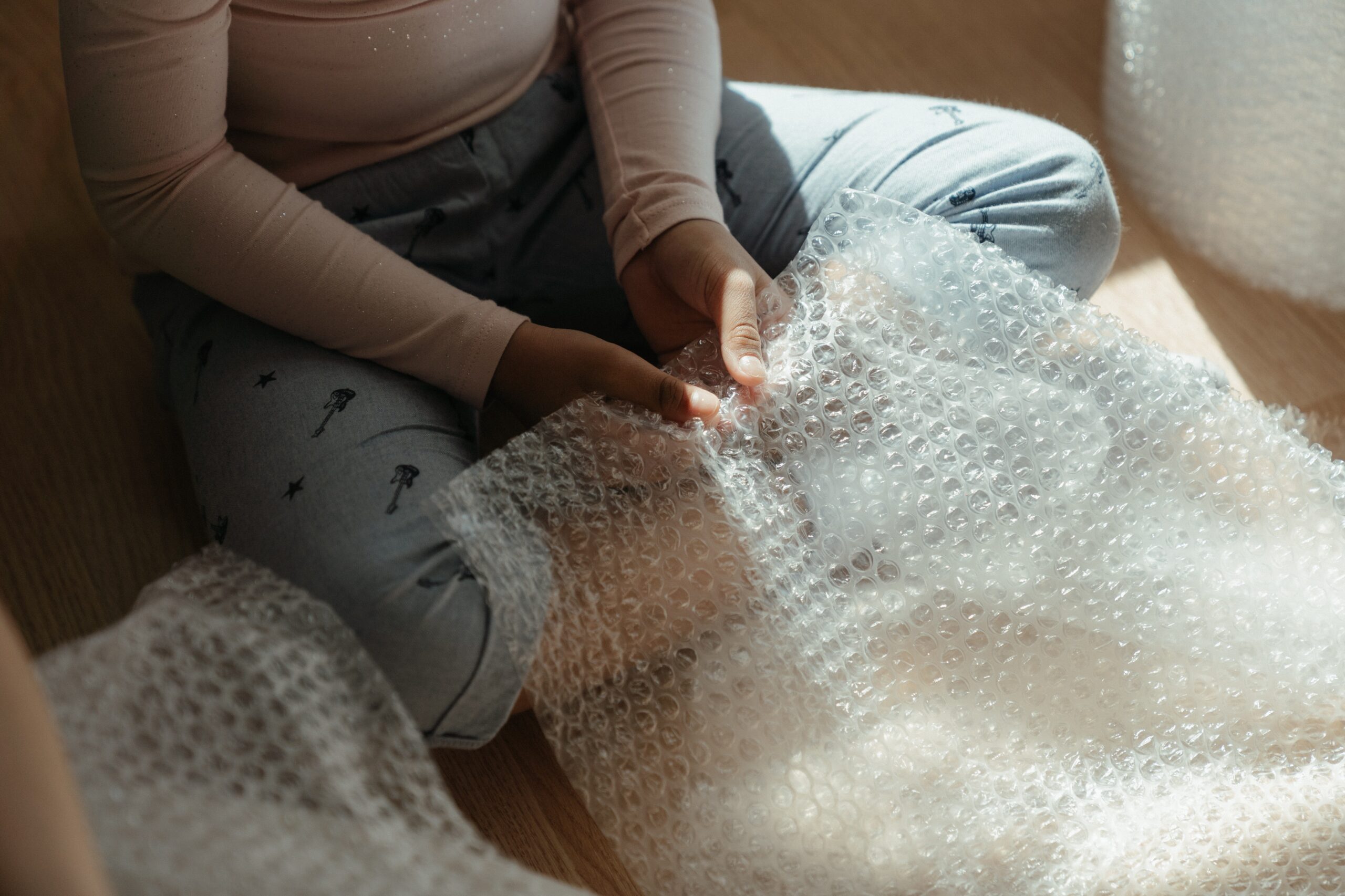
When using this material, make sure you let the bubble side face inwards so your item is more securely wrapped. It is also recommended that you line the inside of your box with bubble wrap to provide added cushioning within the box.2. - Foam Sheets
Like bubble wrap, foam sheets are also thick and padded, thus being suitable for fragile possessions that need more protection.
However, foam sheets are thinner than bubble wrap, so you can usually fit more items in your box when using them. You can use packing tape to secure your packaging more when using foam sheets, ensuring that you do not leave any side exposed. - Tissue Paper
Tissue paper is a helpful packaging material that you can use to provide an initial layer of covering on your fragile items before putting on the bubble wrap or foam.
It's most commonly used for delicate things like fine china and silverware since you want to avoid scratches or damage of any form. To use tissue paper, all you have to do is cut out a neat sheet and secure it with scotch tape. - Loose-Fill Chips
After packing all your belongings and placing them in boxes, you may notice a few void spaces due to the shape of your things. When this happens, loose-fill chips can come in handy to fill in these spaces.
They are extremely useful since you want to get rid of as many gaps as possible in your packing boxes to keep all your things intact while the boxes are in transit.
Where to buy packaging materials in London?
Another concern you may have is where to buy packaging materials. Common options would usually be online stores or the supermarket.
You can always buy it there, but if you’re going to use our temporary box storage services, you can order it while placing an order.
It saves you the time and hassle of having to look for materials elsewhere!
Packaging may not be the most enjoyable thing to do, but when you do it, do it right.
Handbags can indeed be a woman’s best friend, acting as the perfect complement to any outfit and the ultimate place to keep personal belongings.
Truly, you can never go wrong with having too many bags. The problem is that there's not much space for all of them. You must get creative with handbag storage ideas.
It can be fun to switch around your handbags on separate occasions, but without proper organisers, you may find yourself leaving them on the table or stuffing all your bags in a cabinet after using them.
If you have a situation like this on the image, you really need some handbag storage ideas.
Fortunately, there are tons of creative and easy ways in which you can organise your handbags. From bag racks to door-mounted hooks and shelves, here are five fun and creative ideas for you to store your handbags properly.
Handbag storage ideas you can recreate tomorrow
#1 Cabinet with shelves
For the true handbag lovers and collectors, dedicating a separate space solely for storing bags is certainly worth the effort. You can think of it as a second closet, but designed for your handbags, so add in some shelves and drawers to store your collection.
You can play around with the design and go for straight shelves or add partitions to separate each bag.
Whatever design you choose, make sure to allocate enough space to store each of your handbags.
#2 Wall-mounted shelves
No space to add a separate cabinet for your bags? If so, you can achieve the same storage space by mounting some shelves to your wall and arranging your handbags as you see fit.
Try tilting the bags at a slight angle, so you can fit more into each shelf. Likewise, avoid overcrowding the bags, so you can also display your collection in your room!
#3 Display Shelves
If you want to showcase your handbags while keeping them tidy and organised, you can get or build a shelf with compartments to place your bags in.
Having the compartments allows you to separate each bag from one another, so you can preserve their condition and maintain their quality.
#4 Hanging hooks
If you're struggling to make space to build a cabinet or some shelves for your bags, you can always make use of the space you already have in your closet.
Use hanging hooks and place them on your closet rod to hang your bags in an organised way. With this storage idea, you can easily grab your desired bag after picking your outfit of the day, effectively saving you time.
Alternatively, if your closet is too full and can no longer accommodate space for your handbags, you can mount a hanging rack to an empty space in your wall.
The rack essentially acts like a closet road, where you can place hooks to hang your bags. To save space, you can also place two bags in one hook, provided that your rack and hooks are strong enough and the two bags are of different lengths.
#5 Hanging hooks over-the-door bag rack
Another great space-saving idea to organise your handbags is to opt for vertical storage. Your door can be the perfect place to do this. Mount an over-the-door bag rack or organiser to your door, so you can easily get your desired handbag before leaving and hang it back right after use. As a bonus, placing a bag rack on your door can serve as a beautiful display of your handbag collection, which can add personality to your room.
Do you have tons of handbags but struggle to organise them? If so, try out one or more of the five ideas mentioned above.
When you have too many of them and you're still not ready to give them away, you can move them to storage. Just box them and we will pick them up - it's easy, check out how it works.
To a musician, instruments are the most valuable possessions. Some guitarists swear their instrument is like a third limb.
Playing an instrument is a need, and creating music in front of an audience is a thrill.

However 2020. happened (unfortunately) and the concert part of being a musician is cancelled. Of course, a lot of people still play, create and publish online. However, their concert equipment and extra instruments are lying around. Waiting for better times - spring 2021, if we're all lucky
If that person is you, you could put away your instruments and musical equipment somewhere safely, in a storage unit or in box storage.
Just follow these simple rules for storing instruments, and you're all ready for a pick-up.
To do list for storing an instrument in a storage
1. Clean your instrument
Start by cleaning your instruments thoroughly using the proper solutions and cloths or pads. There are cleaning tools used specifically designed for instruments, so make sure to use these. Doing this is important to prevent dirt and moisture from building up while your instruments are stored.
2. Disassemble instruments if possible
If your instrument is made up of parts that can be disassembled, take it apart before storing into a unit. Loosen the strings in stringed instruments and drumheads in your drum sets, then remove reeds and mouthpieces in brass instruments. For those that cannot be disassembled, such as a piano, you can instead opt to place a tarp or sheet to prevent dust from collecting.
3. Store the instrument in the original case
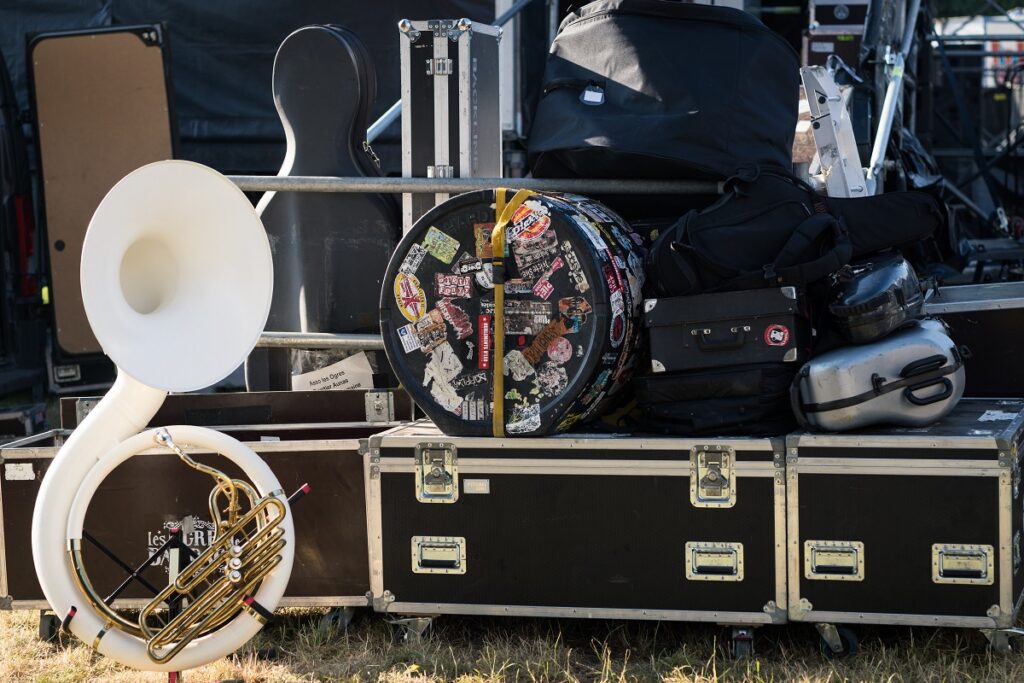
As much as possible, it is best to place your instrument in its original case before putting it into a storage unit. Though the purpose of renting a unit is to keep it protected, you still have to pack your instruments carefully before storing them. Storage companies, like Access Box Storage, require instruments to be stored in a travel case before accepting them to ensure that they are protected while inside a unit.
4. Get a unit that has the right temperature
Climate control is crucial for musical instruments, so when renting a storage unit, make sure to ask about the temperature. Exposure to high humidity can cause moisture to seep into your instruments, and this can be particularly damaging for wood instruments as the moisture can cause wood to expand and crack.
A reputable storage company will be able to answer your questions about How to store instruments in a storage unit? They will likely be familiar with the importance of proper temperature for instrument storage.
5. Check your instrument
After placing your instruments and musical equipment in your storage units, it is highly recommended to check on them every few months, or more frequently depending on how long you plan to store them, to ensure that they remain in good condition.
Doing a periodic inspection can help you check for potential issues like warping or cracking, which can be fixed if brought to a professional for repairs immediately. During this time, you can also tune up your instruments and lubricate them if needed.
Are you ready for storage?
When you decide it's time to store your instrument for a while, measure your instrument case and place your request.
Your case will be picked up on the scheduled date, then stored in a secure facility with proper alarm systems.
You can then check on your units at any time, and whenever you need your instruments back, they will be delivered to you.
Finding a room to rent in London isn’t an easy task, and most outsiders would be shocked when they see how such a small space can command very steep prices. The city probably has one of the highest rates per square foot when you compare the area to the average rent.
The simple reason is that housing in the UK is costly. Landlords have to make profits from their investment.
As a result, those on a shoestring budget are forced to share the flat with other mates. And that can be a major adjustment, apart from acclimating yourself in London.
According to estimates, the average rent for a basic flat in London is £1,665 per month. The rate is also increasing by three per cent every year. The rental rate also depends on which area is the property located.

For example, a studio flat in Barbican, Westminster, and Marylebone would cost you upwards of £1,800. However, you can still find some studio flats in Ilford, Dagenham, Purley, and South Norwood for under £750. The rent in Wallington is only around £200, but it’s best to steer clear of that area because of the high crime rate.
However, if you are looking to rent a cheap room in London, we’ll try to help you with some tips.
Tips to find a room to rent in London
- Keep it real
Put everything on paper-- your budget, your expectations, and distance to work. When looking for a room, don’t only base your decision on the price. You also have to commute to work.
For example, if your office is only a walking distance from your flat, it should save you a lot of money in transportation costs over time.
Would you rather waste an hour on more on public transit every day just because you save a few pounds on your rent?
- Focus your search on only one London area
Several websites approximate the average prices of room for-let in London. You can focus your search according to your budget. It’s best to avoid blowing your budget on the flat. You need a lot of room to manoeuvre when it comes to your cash flow, especially if you’re new to the city as there might be some expenses that you are not aware of. Also, you have to research the neighbourhood & need to make sure the essentials are available, transport is accessible, the area is safe, and it is near your place of work or school.
If you are going to flatshare, you also need to be aware of the most expensive boroughs in London. Here are some of them:
- South Kensington/Knightsbridge
- St Paul’s
- Holland Park
- West End/Soho
- Strand
- Holborn
- Westminster
- Pimlico
- Belgravia
- Chelsea
- Aldgate
Expect to pay upwards of £1,100 even if you are sharing a flat with someone else.

- Search online
Here are some of the platforms that can help simplify your search for a flatshare in London.
Nestpick. The website has one of the largest databases of flats in London. Unlike other websites, the company only lists furnished and semi-furnished apartments, which means that they are move-in ready. You don’t have to worry about buying the basic furniture.
You can categorise your search from the studio, apartment, room, and student residence. Input the date of your target move-in date, and the website will parse the search results for you.
Study Abroad Apartments - If you’re a foreign student in London, the website is an invaluable tool to find a room that suits your budget. You can also filter the search according to your budget, or whether or not you want a whole apartment, a room, or a bed.
Open Rent - One of the best things about this website is that it doesn’t require an admin fee, which saves you some much-needed sterling. There are also no dead listings, which means all the rooms or flats you find on the website are available. It’s a platform for both the landlord and the renter.
What to do when you’re homeless during the search?
Ideally, your accommodations should be ready before you pack your bags and travel to London. However, if you find yourself without room to sleep in while you continue your search, you can rent an Airbnb for the meantime. The advantage is that they are all over London, and you can focus your search on your target borough so that you can get a feel and vibe of the community.
Among the most popular boroughs for Airbnb are:
- Hillingdon
- Southwark
- Camden
- Westminster
- Tower Hamlets
Hillingdon is not surprising because of its proximity to Heathrow Airport, and travellers would rather spend the night in the relative comfort of a bed than the cold chairs at the airport.
To save on rent, you can settle for a room, which will cost you between £42 and £128 per night. The expenses can quickly ramp up when you fail to find a room or flat the soonest possible time.
Another alternative is CouchSurfing, which is similar to Airbnb in the sense that you need to register. It is a community of 120,000 hosts in London. The best thing is that you do not have to pay in cash, and despite the name, you don’t always have to sleep on the couch.
You can also rent some extra space in London where you can leave your luggage and other stuff as you couchsurf or rent a temporary Airbnb room. A storage system is an excellent option so that you can move around to find a place or flatshare without worrying about the safety of your belongings.
Finding a room in London may seem intimidating, especially when you realise that the prices of rent are somewhat prohibitive. Nevertheless, it is not an impossible task. As you can see, the location is crucial as some boroughs are more expensive than others. Simply follow the tips above and pretty soon, you will find the ideal place for you.
Having a small garden, balcony, or patio can be beneficial during the warmer months as you can get much use out of them during this time. With remote work becoming a norm today, many choose to work from home on their balconies to enjoy the natural light and fresh air.
Generally, having an outdoor garden can be fun and relaxing, with you lounging around to enjoy the cool breeze and weather.
During the colder months, however, you will likely spend more time indoors. In the United Kingdom, October to January are considered the wettest months, so you will need to think about how to protect garden furniture during this time. While your outdoor furniture may stay intact and durable for most of the year, the same cannot be said during the winter season.
The snow and the freezing rain can have detrimental effects on your outdoor garden furniture, so it's essential to take the right steps to protect them. With winter around the corner, it is time to start preparing your furniture for the season.
There are actually three ways how you can store your garden furniture during winter:
- Use covers.
- Store it in a shed or a garage.
- Store in a storage facility.
Use covers to protect your garden furniture

If you don't have any space to store your garden furniture, you will need to place outdoor covers on them. Even if you decide to store your furniture elsewhere, it will still be beneficial to put covers on them to prevent dust and dirt from accumulating. Invest in high-quality waterproof covers that can protect your furniture from winter weather conditions like snow, sleet, and rain.
The advantage of having furniture covers is that you can use them all year round and not just during the winter season. Most covers are also UV-resistant, so if you are not using your furniture due to high temperatures, you can also fit the cover to protect them from the sun.
With that said, covers can range in price, but if you plan to leave your furniture outdoors, you may have to spend more to get a quality cover. Likewise, you will need to clean your furniture and apply sealant before covering them, which can take up lots of time. Since the furniture will be left outside, you will also need to secure them well with anchors, cords, and anything to hold them down.
Put your furniture in a garage or shed
Storing your garden furniture in a garage or shed is considered the best way to protect it from harsh weather conditions. The main advantage of doing this is that your furniture will have sturdy protection as they are kept away from weather exposure and placed in a covered area. Some types of furniture, such as those made with wicker or rattan, are more susceptible to damage when left outside, so storing them somewhere is imperative.

There are many ways to maximize the space in your garage or shed to ensure that your furniture pieces fit. Some furniture are collapsible, while others can be stacked up, so work your way around to make use of the space you have.
Should you decide to store your furniture, for the time being, the potential drawback will be the time and effort needed to prepare for it. You will need to remove and clean any cushions and store them indoors since your garage or shed can get damp, and the moisture can cause a build-up of grime or mildew. Before storing the cushions, make sure they are completely dry to prevent water damage.
Also, one major drawback for many Londoners would be the lack of space. It's hard to store furniture in a shed or a garage when you don't have one!
Keep your garden furniture in a storage facility
So, you have nice garden furniture, but no garage or shed. Also, garage rental In London isn't an option. You could literally buy 10 new garden furniture for the price you would spend on that.
So, one other option is keeping the garden furniture in a storage facility till spring. Much cheaper than renting a garage.
Plus, you don't even have to worry about transportation, the storage company will pick it up.
How does that work? Simple. But, the first step for you is to ask about pricing, as we're sure your garden furniture doesn't fit in a box.
Breaking-up with your partner is never easy, especially if you shared a home. The one that moves out usually leaves a lot of stuff, leaving the other one with the questions like "How long do I need to keep my ex's stuff?" and "Can I throw my ex's stuff away?"
As the emotional cleansing isn't enough, you're probably wondering how to deal with the home clean-up. And you're right to wonder, as you can't just throw or give someone else's stuff away.
If you have a pending court divorce in the UK, you can't throw away your ex's stuff. You will probably have to pay up for that.
The only way to legally get rid of your ex's stuff is:
- Send a valid document to your ex in which you inform him/her you'll dispose of his/her belongings after a specific date. Usually, the given deadline is three months from the letter date.
- Keep the items until the date you stated in the notice.
- Get rid of the things and throw a party.

This is the worst-case scenario. If you're lucky enough to have a civilized break-up, maybe there's something else you can do.
After break-up cleaning advice
Try to talk it out
One of the first things you can do is try to have a civil conversation with your ex about the matter. Discuss your plans about cleaning up your home and trying to convince them to take out their stuff by a certain time. Try to be reasonable by giving them a reasonable deadline to pick everything up.
No talking, no throwing
No matter how much you may want to clear out your home after a breakup or divorce, you must still respect your ex’s belongings. Thus, you should not throw out or give away any of his or her things without prior notification. If you are currently going through the court divorce process, then acting on impulse and without notifying your ex can cost you money.
Box in silence
Once you have notified your ex about your plans and next steps, you can then clear out his or her stuff and put them in boxes. In a way, you can think of this as a time to gradually get rid of the baggage and clutter, so you can be greeted with a clean space that can signal a new beginning for you.
How to get the boxes full of your ex’s stuff out of your sight?
If you're in a position you have to keep your ex's stuff, but you really can't stand to watch them, you only have a few options.
Make your ex collect them
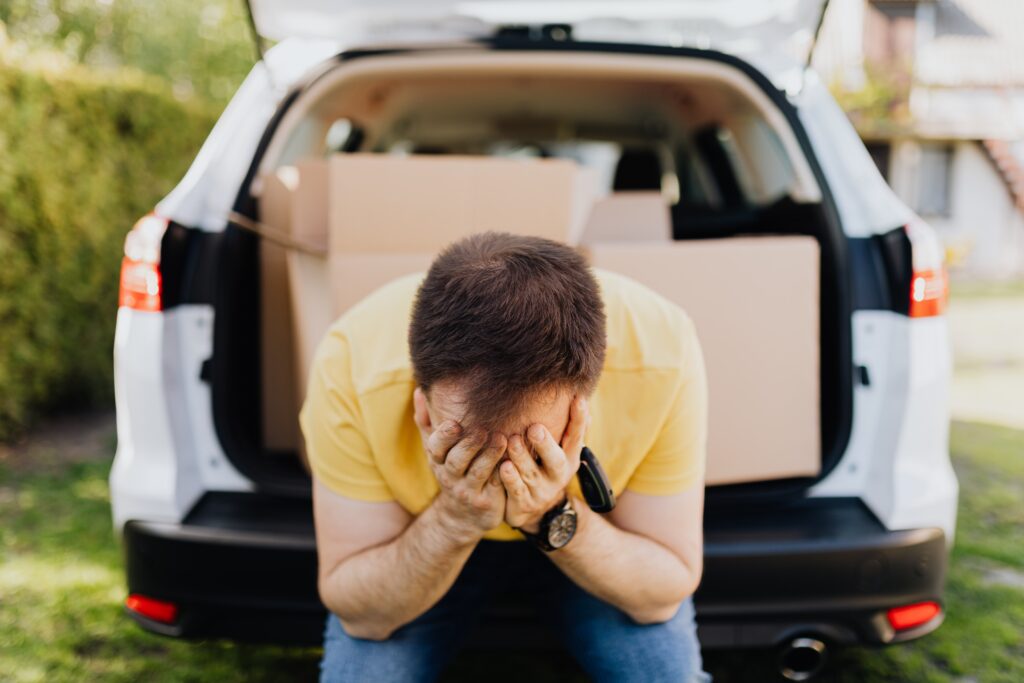
(and not so common)
The quickest and most convenient way, on your part, will be to have your ex come over to pick up the boxes. However, this option may be more difficult if you are not in good terms or currently not speaking with each other.
Send the boxes over the post
If it is difficult to make arrangements for your ex to collect the boxes on his or her own, you can also send the boxes over the post. Postage costs in the United Kingdom will vary based on the courier you choose and your package's weight. Generally, costs can be as low as £2 to £3, but this price will likely apply for small items like books or stationery with a maximum weight of 1kg. Imagine the cost of sending all the things left behind! Also, your ex could refuse to take the parcels.
Place the boxes in storage
The last and the best option for getting rid of your ex's stuff is to put them in a box storage unit. Box storage businesses, one of the top industries today, deliver free boxes with a capacity of up to 25kg and will collect the boxes from your home once they are ready for pick-up. These boxes will then be stored in their facility, which is monitored 24/7 with security and alarm systems, so you can be sure that the items will stay safe.
Whenever your ex is ready to get his or her things back, you can book a return date with the box storage business to have them delivered to their address. This option is highly flexible as you can also schedule the delivery one box at a time if your ex needs time to sort the things out, but you do not need to leave the boxes lying around at home.
And when you clean up, your life is getting a new beginning. Sounds easy, right?
Whether you're packing up to move into a different neighbourhood for your dream home, to a new dorm room, or to the city for a new job, one thing is sure: you need to pack some moving boxes and organise.
Most people start sorting and packing weeks before the big move. If you want to be able to do this efficiently, you must know how to pack boxes for moving to help you secure your items, keep everything organized, and most of all, make unpacking much easier.
If you’re wondering how to start and what to do, you landed in the right place. We’re sure these tips and tricks will help you.
The box packing strategy tips
Start packing with the right materials and tools
The most common items you need for your big packing task are boxes, packing peanuts, bubble wrap, packing paper, tape, scissors, marker, and of course, moving boxes. You may also need to prep a box cutter, in case you need to pop open a box that you've sealed.

Don't forget to prep a dust rag to get rid of dust bunnies on your books and other stuff before you place them in the container. Ziplock bags for small items are also beneficial for organizing your stuff. The key is to put your things properly so you'll have an easy time unpacking when you get to your destination.
Choose the proper boxes for moving
You may be hiring professional movers, or you could be making the big move on your own. If you're moving from one place to another in London, you can use our storing services in between the move and get boxes for free.
However, if you're attempting a DIY move or your chosen movers don't include packing materials, buy new boxes.
Even though it's tempting, don't just get free old boxes from the grocery. Avoid anything that once contained food and drinks. Past spillage, though dry, can still attract insects like cockroaches, ants, or mites. It would be a terrible nightmare to bring these pesky pests into your new abode. Old boxes are also less sturdy, so the safety of your stuff is compromised.
Plan ahead with a list and schedule
After you have your moving equipment sorted, the next to do thing is to make a list of how to organize packing boxes for moving. Packing can be stressful and overwhelming, but giving yourself attainable goals and the timetable to achieve them will ease your burdens. Doing this ahead will also give you a chance to declutter. Throwing junk and moving the essentials will be cheaper and more manageable.
Make a complete moving checklist, so you don't forget anything.
Prep those moving boxes
If you are wondering how to pack boxes for moving, one thing you must prioritize is to build a strong foundation for your belongings. Don't forget to line the bottom exterior with tape for an added layer of security.
Pad the bottom of the interior with crumpled paper, towels, or bubble wrap, and this serves a shock-absorber in case someone drops the box. These materials can also absorb (water or paper) or repel (plastic bubble wrap) water in case the box gets wet.
Fill the boxes properly
One of the best strategies is to organize your boxes for moving based on the contents of the room. That way, everything is grouped, and you can unload them where they need to go. As a general rule, items like clothes, files, or picture frames must stay together. Don't forget to bubble wrap the breakables!

Bear in mind that you also have to handle the weight of the moving boxes. The suggested max weight load a person can carry without hurting the back is 25kg.
Try to mix your heavy items, like books with a few lighter ones to stick to that weight limit.
If you have space left to the top, add packing peanuts. The goal is to keep the top firm so it won't cave when you stack the boxes when distribution time comes.
Label the moving boxes
Don't forget to label your boxes!
Mark which room does a specific box belong to and make a rough list of contents.
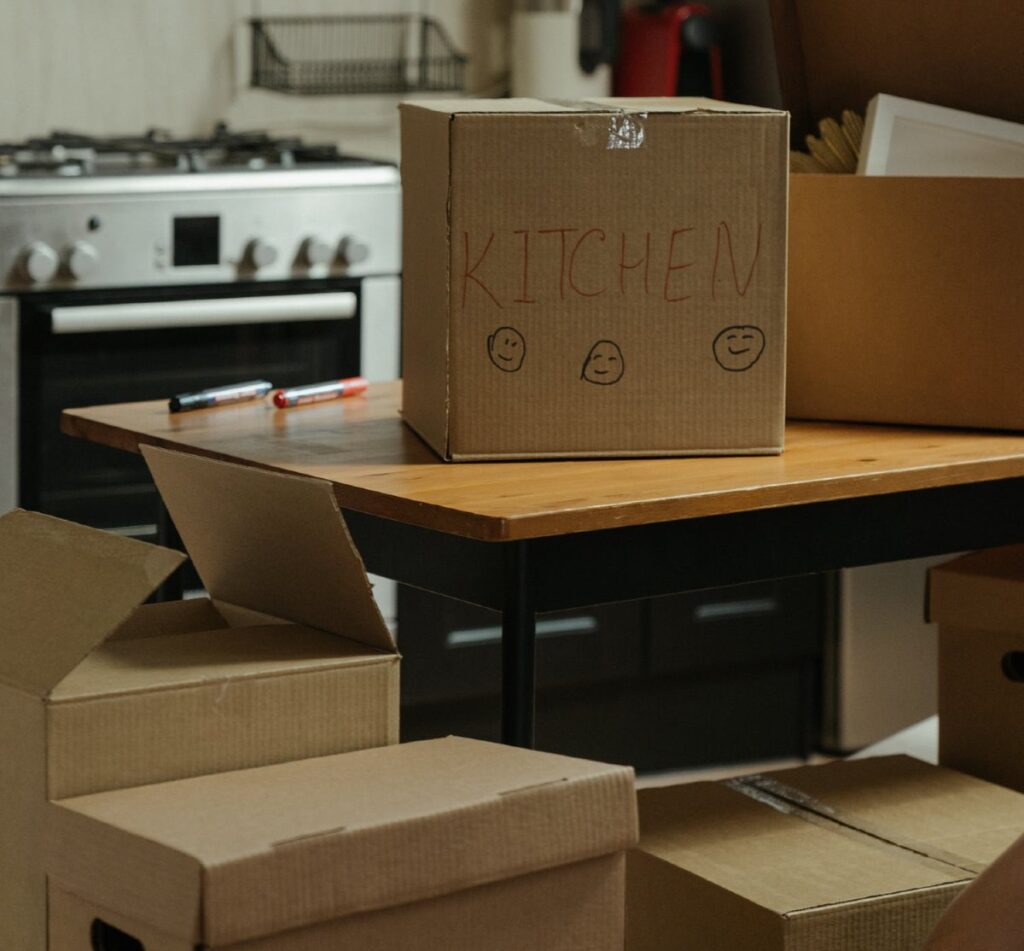
Photo: cottonbro, Pexels
This method will help you determine if something goes missing along the way. If you're moving to a dorm room, don't forget to include your name and room number.
When you are faced with a sea of boxes once you unload, you will pat yourself on the back for going the extra mile and labelling every box. Be sure to put that last thing you need in the moving vehicle first. This way, you will be able to unload the essential items first when you arrive.
Do you need some extra space?
We hope we helped you with the moving tips. Home-moving is stressful as it is finding extra space between the move. If you need it, you can always ask us, and our services will come handy.
We can collect your boxes, store it and deliver them back when they're ready. And yes, you can request to pick them up and one London address and have them delivered to another!
The ultimate list of house move packing materials
- Cardboard boxes
- Bubble wrap
- Packing peanuts
- Tape
- Labels
- Moving sheets
- Straps
- Bins bags
- Wipes and cleaning products
- People
- Car or van
- Tools
1. Cardboard boxes

When moving home, packing your belongings into cardboard boxes is standard practice.
Cardboard boxes come in a variety of different shapes, sizes and qualities, so it’s important that you pick the right sizes relating to the items you wish to store.
Belongings such as cutlery, glassware, and trinkets are perfect to transport in cardboard boxes. Just make sure to use plenty of protective materials inside the box to keep them secure.
When using Access Box Storage, we deliver cardboard boxes to your door as part of our storage solution, so there’s no need to buy any when storing with us.
2. Bubble wrap
‘Bubble wrap’ is a plastic packaging material that contains many pockets of air. When packaging precious or fragile items, wrapping the items in bubble wrap before putting them into a box will help to stop them from becoming broken or damaged during transit.
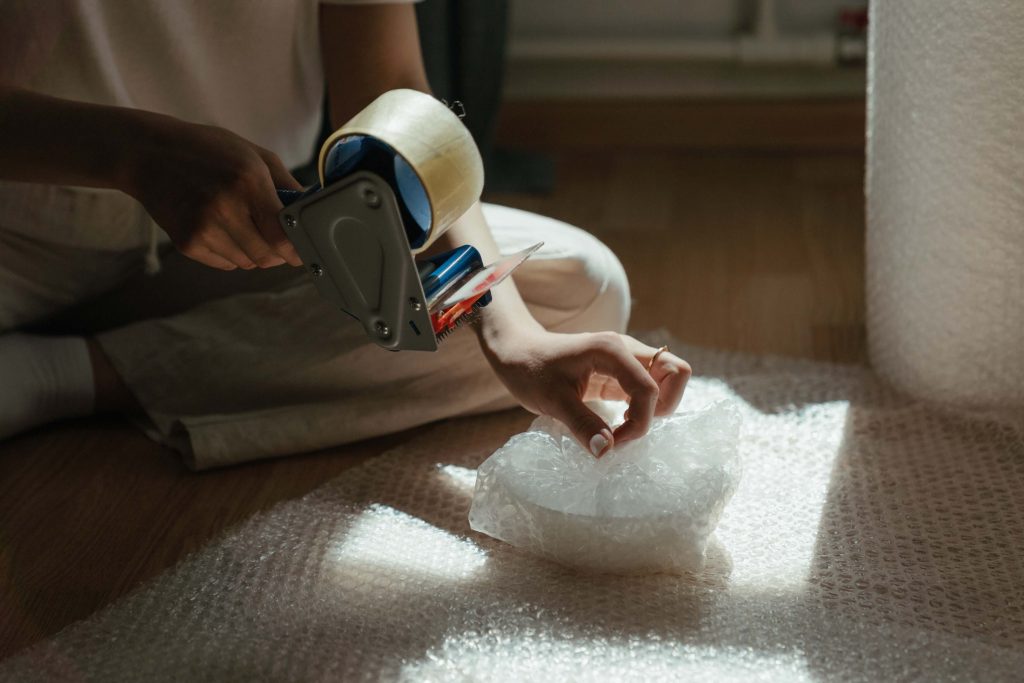
If you’re looking for a more environmentally friendly option than plastic bubble wrap, you could think about repurposing old towels, clothing or bedding, which will offer your fragile items similar protection.
3. Packing peanuts
Packing peanuts are another common material used to prevent damage to fragile items during transportation. When placed inside a box alongside your belongings, they compress together to keep items in place and act as a cushion to prevent damage from occurring.
4. Tape
Choosing high-quality packing tape is extremely important when moving house. Ensuring that your boxes are taped up correctly with strong tape will help ensure nothing is damaged during the moving process, and keep your boxes firmly together.

5. Labels
When everything is packaged together inside a box and moved to another location, it can be difficult to remember what’s inside it! Especially when you have lots of boxes with your belongings in them.
When you move your boxes to your new property, it’s best to put them in the correct room where you’ll be unpacking their contents.
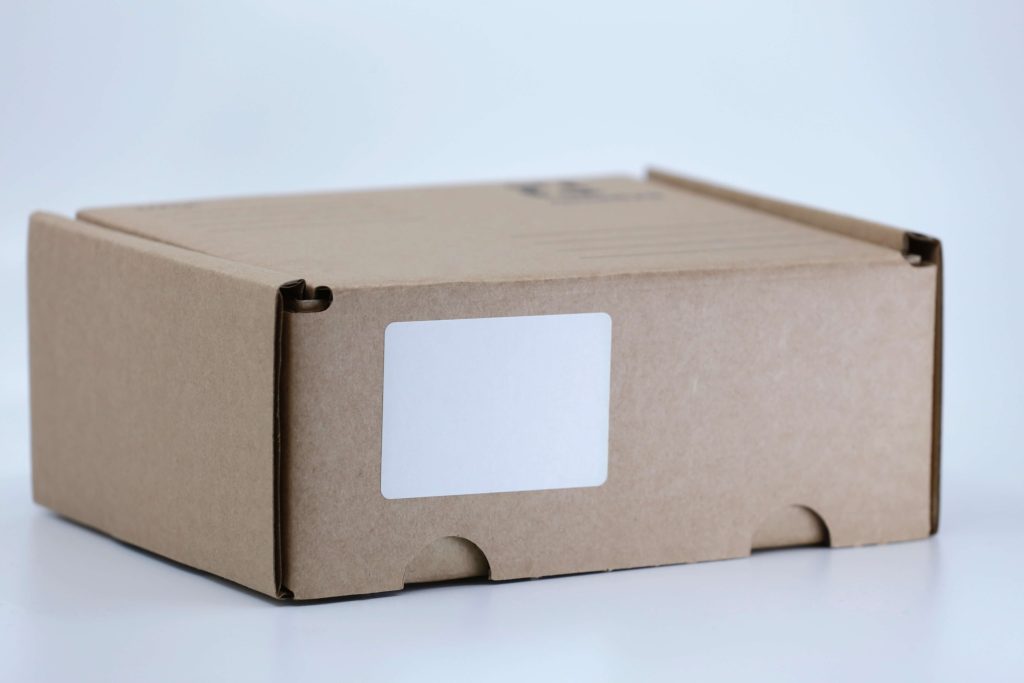
If you’re not certain what’s inside each box, you’ll have to open each to discover its contents randomly. This can be frustrating when you’ve opened a box downstairs that needed opening and unpacking upstairs!
Also, if you’ve enlisted the help of friends and family to move the boxes, they won’t know what’s inside each box you’ve packed.
That’s why applying labels to each box you’re packaging is extremely beneficial and can save you a lot of time and effort in the future. Consider writing what’s inside the box, or the room where you want the contents unpacked on the label to help yourself and others that may be helping you.
6. Moving sheets
It can be risky moving furniture from one location to another, as it’s easy for your belongings to get damaged in the process. Large pieces of furniture could also cause damage to your old or new home whilst trying to navigate doorways and other tight spaces.
Moving sheets can be a handy tool to help move things safely, and prevent unwanted damage or accidents when moving into a new property.
7. Moving straps
Moving straps are another packing essential that can be extremely beneficial to the heavier parts of the moving process.
These straps are designed to aid the lifting of heavy furniture such as wardrobes, mattresses and TVs, in order to reduce the physical strain on your body and prevent wear and tear on your belongings.
8. Bins bags
When you’re moving out of your original house, it’s key to use this opportunity to throw away what you want to bring with you, and what you no longer require.
Sorting through possessions to give away or throw away before you move, means less stuff to move on the big day, and less stuff taking up space in storage.
If you have plenty of bin bags available, you’ll be able to easily dispose of what you’re ready to part with. And, as well as saving yourself time and effort when moving this excess stuff, you’re reducing clutter in your new home, ahead of time.
And, bin bags also make good packing vessels for transporting bulky soft items such as duvets, sheets, and pillows. Just make sure to label them, so you don’t mistake them for rubbish!
9. Wipes and cleaning products
Before you move all of your furniture into storage or into a new home, it’s a good opportunity to give everything a good clean first. This means all your belongings will be in pristine condition when you move into your new home, and there’ll be one less job to do within the stressful house move process.
It’s also useful to have wipes and other kinds of cleaning products to hand throughout the moving process incase you need to clean as you go.

10. People
When you’ve got heavy furniture to move, boxes to unpack, and cups of tea to be made, there’s only so much work you can do alone. The more people you can enlist to help you move, the better!
Despite not being a packing material, people such as your friends, family, or a removal company can be the essential piece in reducing the stress of a house move.
The Access Box storage team can contribute to this effort. Clear boxes out of your old house ahead of time to make cleaning and moving easier. Then, when you’re ready for them, we can deliver your boxes straight to your new address, cutting out a significant amount of the heavy lifting.
11. Car or van
Moving your possessions from one place to another can’t be achieved without some kind of transportation, such as a car or van.
If you’ve got larger, heavier items to transport into your new home, then you will need to hire a van or find someone who has a van to help you with the moving process.Or, if you live in London, our box storage solution provides a handy alternative to hiring a van or a car. If you live in London, we can save you the hassle by collecting boxes of belongings from your old address, and delivering them to your new address.
12. Tools
If you’re moving furniture from one place to another, you may need to take down the furniture first before assembling it at the new property. Tools are an essential piece of this puzzle, so make sure you have all the necessities ahead of time to avoid stress on the day.

Preparing this ahead of time, will make taking furniture apart and reassembling it as easy as possible.
If you’re thinking about storing your furniture in between house moves, check out Access Self Storage for quotes and pricing.
Where do I start when packing to move home?
In addition to prepping your packing materials before moving house, there are some other important things to consider before you just start packing up items without a plan.
Try putting some of these things into practice, to make packing streamlined and stress-free.
Start early
Make sure you start packing your possessions as early as you possibly can. The more time you give yourself, the longer you have to ensure that everything is packed up in time.
Leaving everything until the last minute can be extremely stressful. So, help your future self, and start as soon as you can!
One way you could make a start, ahead of time is using box storage to clear space taken up by unneeded items in your house. For example, if you’re moving house in summer, why not clear out any bulky winter clothes and shoes, and have them redelivered to your new address once you’re moved in.
Work through your home room-by-room
Moving through each room one by one is a great way to ensure that you don’t miss anything when packing.
By following this strategy, you will ensure that no stone is left unturned, and working methodically through each room in your home will ensure you have a strategy in place.
This also helps make unpacking easier, as you can pack things from each room in the same boxes, and use the labels you prepared earlier to help you keep tabs on what needs to go where. That way you can keep kitchen items in the kitchen, bathroom bits in the bathroom and bedroom belongings in the bedroom.
What should you not pack when moving?
There are several items that you should avoid packing when moving home.
Firstly, anything that you don’t need any more; don’t move it to your new house! There is no better time to sort through what you need and don’t need, than when you’re packing to move home.
With the items that you no longer require, you can throw them away if they have no further use, sell them, or donate them to a charity shop.
Secondly, remember to be wary of packing dangerous items when moving house. This may be self-explanatory, however, it’s worth mentioning that items such as fertilizer, fireworks, or charcoal must be moved separately and not in the van or car with your furniture and boxes.
What is the hardest room to pack when moving?
This depends on the size of each room you currently have and the number of items you have in each room, but there are a few rooms that stand out to us as the most difficult to pack.
The kitchen can be difficult because it contains many breakables such as plates, glassware and cups, which all take a while to pack properly in order to make sure they’re safely wrapped up.
Another room which is notoriously difficult to pack is your garage or shed. This is because a lot of the equipment you store in your garage or shed can be heavy, dangerous or difficult to manoeuvre. Garages are also well-known hotspots for clutter, so it may take longer than you realise to go through every item and decide whether to keep them or not.
Use box storage to help you move home
If you’re moving out and need somewhere to store your stuff, enquire today about our helpful box storage service.
Box storage is a good solution because it’s a cost-effective, convenient and flexible solution if you don’t have anywhere to store your belongings before moving into a new home.
In no time at all, you can order the boxes you require, then we’ll collect your items and take them to our secure storage facility and deliver your boxes to your new home when you request them.
If you have enough belongings to fill a few cardboard boxes, box storage can be a cheaper and more convenient option than hiring out a storage unit.
Another advantage of using a box storage company is that if you don’t have access to a car, moving things on public transport can be difficult, time-consuming, and expensive. You need peace of mind that your belongings are being taken care of and moved to the right place. With box storage, you can request your items to be delivered to your new address to take the stress out of planning to move your belongings.
Head over to our FAQ for more information, and enquire today to order your boxes, and get started with the packing process.
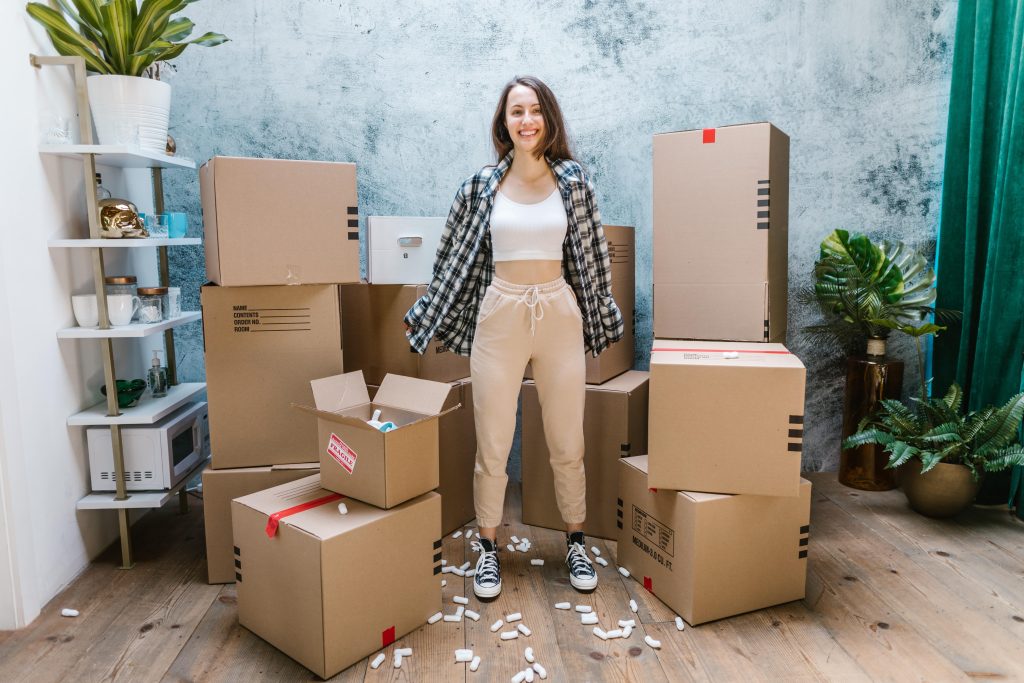
If you’re moving out of one university accommodation into another, the logistics can be stressful.
Knowing how to organise your belongings, which ones you can place into storage and how to move them safely are all key to keeping stress to a minimum when moving student accommodation.
In this blog, we’ll give you some useful tips on all the logistics of moving as a student, from packing your belongings to using storage to make your life a lot easier.
Create a checklist of all your belongings
The best place to start when moving student accommodation is to create a checklist of your belongings. You can use this as a packing checklist to help you move through all the tasks in an organised way. And, when you arrive in your new home, you can refer t to the same list to check nothing has been lost or damaged in transit.
Include these items in your packing checklist to make sure that you're prepared ahead of time:
Important documents
It's so important to keep your important documents safe when moving house. It's all too easy to misplace random pieces of paper if they're not stored away correctly. So make sure to set some time aside to organise a folder or box to keep them all these items in one clearly labelled, safe place:
- Drivers license
- Passport
- Any other forms of ID
- A copy of your accommodation contract and terms of residence
- Bank documents such as statements
- Car insurance documents
- Student Cards
- National Insurance number documents
Electrical items
Packing electrical items away and keeping all the cables with the right item is an important part of staying organised. Listing them and packing them safely will help you get set up in your new house quickly and easily. Your list might include:
- Laptop and desktop computers
- Chargers
- Games consoles
- Television
- Extension leads
- Cameras
- Hair dryers and hairstyling tools
Clothes
Packing away clothes can be one of the most overwhelming parts of the moving process. You may want to consider downsizing your clothing before making a start with packing. Then you can pack your clothes in order of items so that it's easy to unpack in your new home. Sections could include:
- Casual clothes like T shirts, jeans, and trackies.
- Smart clothes like shirts, suits and blazers.
- Seasonal clothes like winter coats.
- Loungewear and pyjamas.
- Underwear, including socks and pants.
- Shoes.
Academic supplies
Settle into your new academic year with ease, and make sure all your university supplies travel with you to your new home. Your checklist should cover:
- Notebooks
- Stationary
- Coursework
- Academic textbooks
- Calculators
- Passwords and access information
Kitchen supplies
Keep your kitchen supplies packed in separate, labelled boxes to the rest of your belongings. Fragile items like mugs and glasses will need extra protection like bubble wrap. Your checklists may include:
- Pots
- Pans
- Plates
- Cups
- Cutlery
- Utensils
- Countertop appliances like blenders or air fryers
Personal belongings
Make sure you don't lose any of your sentimental or essential personal belongings, with a comprehensive list:
- Pictures
- Stuffed animals
- Toiletries
- Bed sheets
- Blankets
- Trinkets
How to efficiently pack your stuff

Once you've made your packing checklist, and organised your belongings into categories, it's time to start packing your boxes.
Items such as clothes, bedsheets, and towels can be packed together. Make sure you properly fold clothes before packing them rather than throwing them into boxes. This may take more time at the packing stage, but it will save you time later by making unpacking easier.
For clothing items like shoes, you should pack them in their own separate boxes, where they’re less likely to be damaged or damage other items due to movement.
Similarly, fragile items such as game consoles, glasses, and plates should be wrapped in protective packing materials like bubble wrap and paper. This will help protect these items and keep them safe.
When packing cardboard boxes, be careful to avoid over-packing. You need to be able to lift the boxes safely and avoid the boxes breaking due to being overfilled.
Place belongings in box storage between house moves

If you’re planning on going home over the summer or have holidays planned, placing your items into box storage is a great way to reduce the stress of moving student accommodation.
It’s a popular option with students because it's cost-effective, convenient, and flexible. If you don’t have anywhere to store your belongings, then Access Box Storage can take your packed boxes off your hands and redeliver them to your new address at a date of your choice.
Simply order the boxes you need, then we can collect your items and take them to our secure box storage facility. Then, tell us your move-in date, and we'll bring them to your door. This means you can avoid the fees associated with hiring a van, and reduce the heavy lifting involved in the moving process too. Our services are especially beneficial for students who don't have a car – providing a good alternative to awkward public transport journeys with lots of bags or racking up an expensive bill from multiple cab trips.
Box storage is a really cost-effective option for students who only have a few boxes of belongings to store for a few weeks or months. In these scenarios, hiring storage by the box is far cheaper than renting a whole storage unit.
Type in your postcode here to see if Access Box Storage is available in your area. Or contact us today for more information!
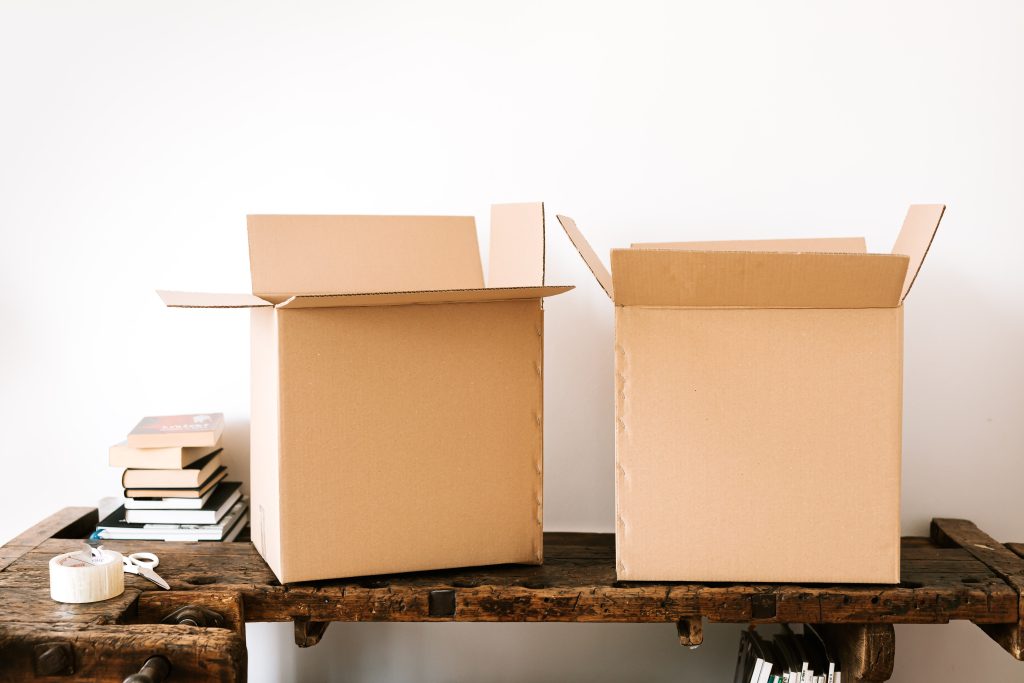
If you’re moving house or office, you might need short-term storage space whilst you get yourself settled. Or, if you’re downsizing, you might need a more long-term solution. Whatever your situation, it's important to know your belongings will be safe when they are in storage.
Access Box Storage has put together 5 top tips for safe storage to help put your mind at ease and make the storage process simpler for you.
1. Choose a box storage company with a secure facility
Theft or damage is always a big concern when leaving your belongings in the care of others. To decrease the chance of any issues, it's important to use a trustworthy storage facility that has strong security in place.
Here at Access Box Storage, your belongings are kept safe and secure in our purpose-built London storage facility. We use top-of-the-range 24/7 CCTV, fire detection systems, and security fences surrounding the perimeter.
2. Buy a safeguard protection
We recommend buying safeguard protection and covering your items for complete peace of mind.
Each box that you store with Access Box Storage is covered for up to £100 per box, which is offered for free. However, if the contents inside the box exceed this amount, you should take out a higher level of safeguard protection.
We offer £150 or £250 of safeguard protection, which works out between 50p or 90p per box per month.
3. Secure Your Small Items and Valuables
Even though our storage facility in London is safe and securely monitored, you can take extra steps to keep your valuables safe. For your own peace of mind, you might want to invest in a small safe or box that you can easily fit a lock on. This will be able to hold your smaller items instead of leaving them loose.
You’ll then be able to wrap this up with our packing materials and place them in the cardboard boxes that we provide for free.
As you prepare to pack your belongings, we recommend wrapping your smaller, more fragile items in bubble wrap to ensure they don’t get damaged in transit.
Place your heavier items at the bottom of the cardboard box and your fragile items on top to prevent any damage. It'll be better to pack your items quite compactly, so the items at the bottom won’t smash and those at the top don’t shift and topple.
4. Keep a list of your stored items
No doubt, if you’re moving house or office, you’ll have a lot of items that you need to put into storage. It can be easy to lose track of everything you’ve packed. Before storing, ensure that you organise your stuff well and write a list of everything you have stored and which boxes they are in.
For even more convenience, Access Box Storage provide you with a list of the unique reference numbers for your boxes. These references can be matched with the itemised list you created when packing each box.
5. Keep up with storage payments
Just as you would pay your monthly rent or mortgage, you must keep on top of your storage payments.
Choosing Access Box Storage is affordable and easy to keep up with payments. You can choose to pay monthly, where your debit or credit card will be automatically charged, making it the easiest way to prevent payments from slipping your mind.
However, if you know you’ll need long-term storage, it may be easier to pay upfront. We offer various discounts depending on your timeframe. For 6 months, you can get a 10% discount, 9 months for a 15% discount and 12 months for a 20% discount.
Safe storage, with Access Box Storage
So, if you’re ready for a safe storage option, Access Box Storage can help you out.
Simply enter your London postcode into our search bar to make a booking and select how many boxes and larger items you’d like to store and how long for. We’ll provide you with free boxes. Then, you can take your time packing and storing, and we’ll come to collect your boxes whenever you’re ready! It couldn’t be easier.
Check out our FAQs if you have any questions or get in touch with us today.